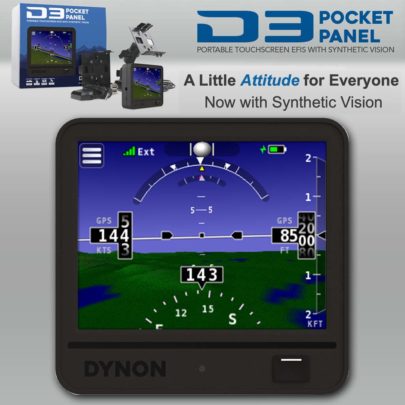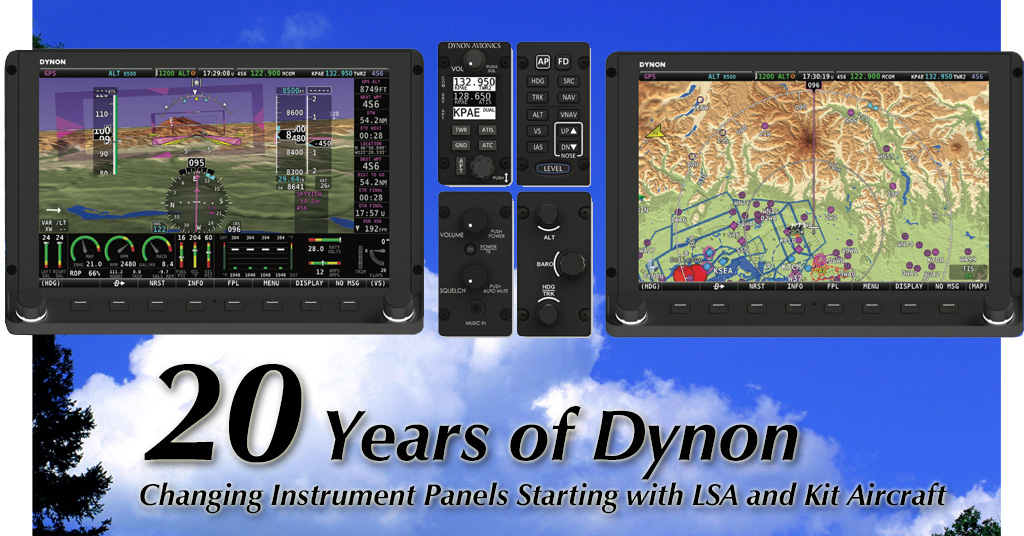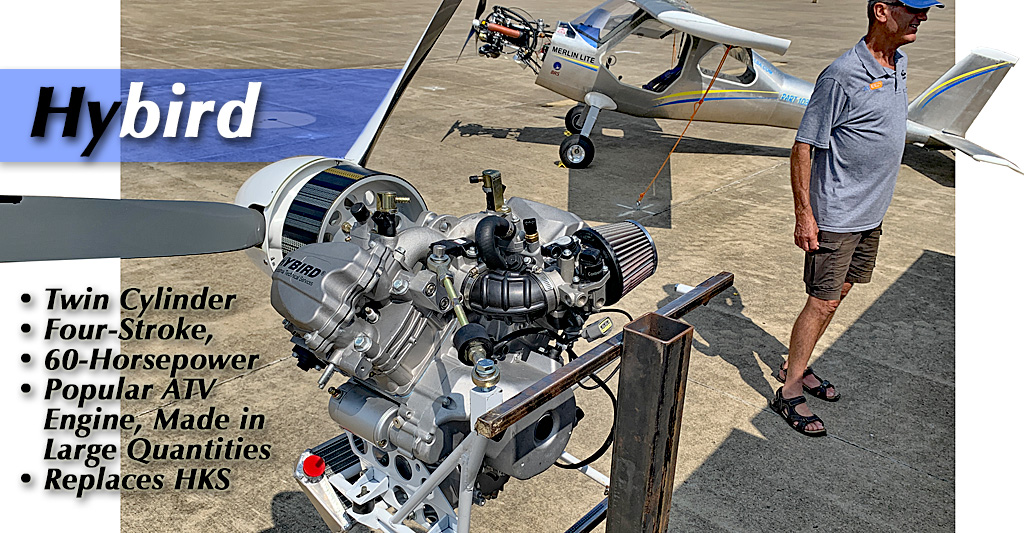 A new engine was debuted at Midwest LSA Expo 2020 for light aircraft from Aeromarine-LSA. Paired as it is with a new engine-specific prop, this is a refreshing bit of news for ultralight enthusiasts and other single seat light aircraft lovers.
It’s called Hybird… and, no, I did not spell that incorrectly. As you’ll hear, the new powerplant has some possibility to be a form of hybrid (this time spelled as you expect) but it is different in that respect, too.
Since HKS decided to exit airplane engines — although our favorite datastician, Steve Beste reports he can still get parts for his HKS — the light aircraft industry has had an ear to the ground for a new four stroke replacement. It appears Chip Erwin has what many are seeking.
HyBIRD, not Hybrid
As those who know him realize, Chip does not just go out and find components for his airplanes and then adapt them to his designs.
A new engine was debuted at Midwest LSA Expo 2020 for light aircraft from Aeromarine-LSA. Paired as it is with a new engine-specific prop, this is a refreshing bit of news for ultralight enthusiasts and other single seat light aircraft lovers.
It’s called Hybird… and, no, I did not spell that incorrectly. As you’ll hear, the new powerplant has some possibility to be a form of hybrid (this time spelled as you expect) but it is different in that respect, too.
Since HKS decided to exit airplane engines — although our favorite datastician, Steve Beste reports he can still get parts for his HKS — the light aircraft industry has had an ear to the ground for a new four stroke replacement. It appears Chip Erwin has what many are seeking.
HyBIRD, not Hybrid
As those who know him realize, Chip does not just go out and find components for his airplanes and then adapt them to his designs.Welcome Hybird — New Four-Stroke Engine for Light Aircraft; Replaces HKS
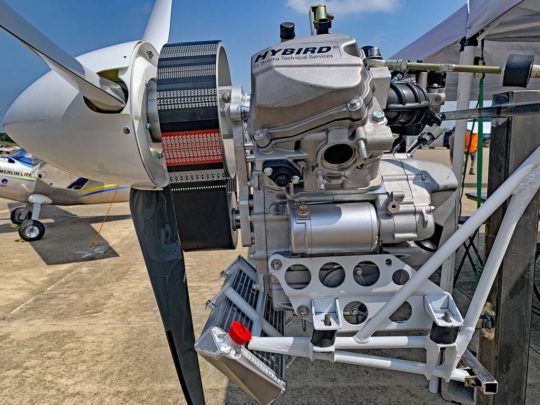
It’s called Hybird… and, no, I did not spell that incorrectly. As you’ll hear, the new powerplant has some possibility to be a form of hybrid (this time spelled as you expect) but it is different in that respect, too.
Since HKS decided to exit airplane engines — although our favorite datastician, Steve Beste reports he can still get parts for his HKS — the light aircraft industry has had an ear to the ground for a new four stroke replacement. It appears Chip Erwin has what many are seeking.
HyBIRD, not Hybrid
As those who know him realize, Chip does not just go out and find components for his airplanes and then adapt them to his designs. He actively works the project. He’s done that with Hybird V-Twin, too. For example, this engine has a custom-designed prop made expressly for his Merlin.
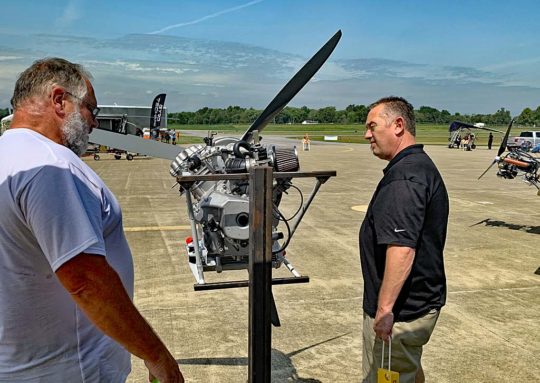
Plenty of pilots at Midwest carefully examined Hybird V-Twin.
No, not Merlin Lite as debuted at Midwest 2020. That Part 103 entry uses the Polini Thor two stroke but for the larger sibling simply called Merlin, the more powerful, four-stroke entry is a perfect replacement for HKS.
“Aeromarine-LSA’s new Hybird V-Twin is a 60-horsepower, liquid-cooled, four-cycle, 800-CC, 80-degree Vee, fuel-injected, electronic engine, with electric start,” said Chip. “This engine incorporates state-of-the-art technology with decades of reliable history and thousands in service.”
“Our matching reduction drive, custom CAD-designed and matched propeller results in the perfect power system for the Merlin aircraft at an excellent price,” stated Chip.
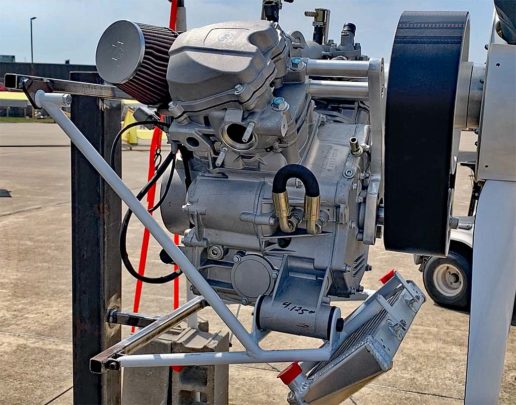
“There is no TBO (Time Between Overhaul),” Chip bragged! “Our engine replacement price is lower than the cost of most overhauls, so it is cheaper to buy a new engine.” A run-out Hybird could still be overhauled, of course, but if that costs close to as much as a new engine, the decision to skip the overhaul time and expense sounds easy.
“We adapted a proven belt reduction drive to this engine and designed a custom engine mount, exhaust, and wiring harness,” Chip explained. “We even arranged with a PhD-qualified prop designer to create a custom carbon propeller made to match this engine’s torque and power curve.”
An Airplane Engine?
Although companies like Viking, Aeromomentum, Corvair, and AeroVee have converted automobile-based engines very successfully for aircraft, some pilots question if this type of conversion is satisfactory for airplane engines. It’s a reasonable concern for pilots accustomed to very reliable engines such as Rotax’s ubiquitous 9-series.
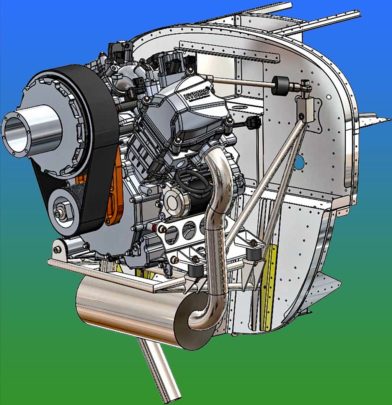
Engineering drawing showing installation of Hybird V-Twin on Aeromarine-LSA’s Merlin.
I see two aspects to this inquiry. The first is about dependability of the engine, specifically it is up to the task of operation the way most pilots will use it? The second refers to alternative ways to use the engine.
Regarding dependability… Hybird V-twin is what Chip describes as “red-neck proven.” Hundreds of thousands of this engine have been manufactured and put to the test in ATVs. “These four-wheel vehicles are run hard in extreme off-road conditions. They have proven themselves to be very durable and reliable,” Chip said. “Plus, this engine is very modern, with electronic ignition and fuel injection.” He added that V-Twin was expressly designed to be run at high power settings.
Regarding alternative uses… the Hybird hybrid is not merely using a gasoline engine to charge up a bank of batteries. Instead, Chip is springboarding from an earlier project between Rotax and Flight Design where a 912 was joined to an electric motor for takeoff boost or emergency power …although the older project was not intended for electric-only propulsion. Here is a similar but different project I wrote about in 2015.
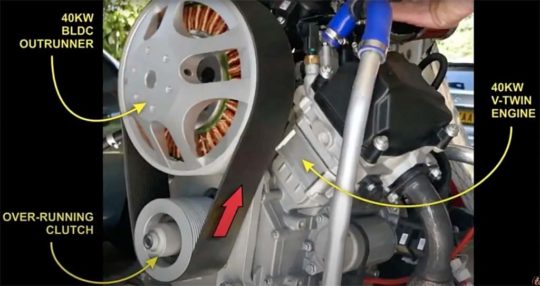
An electric implementation of the Hybird V-Twin engine, reported by Ben Bosma in 2019.
As the nearby image shows, Chip is planning with colleagues to provide an electric motor for added power, with juice supplied by the engine rather than a series of heavy batteries. This is a most engaging idea. I was excited by the Rotax development but that got shelved.
One idea is that an electric motor, in combination with a minimum battery set could provide a short-term boost of power to get you to a landing site without combustion engine thrust. The same arrangement could add power to get you out of a short runway. Additional uses might be forged but simply these two make the idea interesting to me.
Hear directly from the developer, Chip Erwin, about his plans for Hybird V-Twin engine.
 A new engine was debuted at Midwest LSA Expo 2020 for light aircraft from Aeromarine-LSA. Paired as it is with a new engine-specific prop, this is a refreshing bit of news for ultralight enthusiasts and other single seat light aircraft lovers.
It’s called Hybird… and, no, I did not spell that incorrectly. As you’ll hear, the new powerplant has some possibility to be a form of hybrid (this time spelled as you expect) but it is different in that respect, too.
Since HKS decided to exit airplane engines — although our favorite datastician, Steve Beste reports he can still get parts for his HKS — the light aircraft industry has had an ear to the ground for a new four stroke replacement. It appears Chip Erwin has what many are seeking.
HyBIRD, not Hybrid
As those who know him realize, Chip does not just go out and find components for his airplanes and then adapt them to his designs.
A new engine was debuted at Midwest LSA Expo 2020 for light aircraft from Aeromarine-LSA. Paired as it is with a new engine-specific prop, this is a refreshing bit of news for ultralight enthusiasts and other single seat light aircraft lovers.
It’s called Hybird… and, no, I did not spell that incorrectly. As you’ll hear, the new powerplant has some possibility to be a form of hybrid (this time spelled as you expect) but it is different in that respect, too.
Since HKS decided to exit airplane engines — although our favorite datastician, Steve Beste reports he can still get parts for his HKS — the light aircraft industry has had an ear to the ground for a new four stroke replacement. It appears Chip Erwin has what many are seeking.
HyBIRD, not Hybrid
As those who know him realize, Chip does not just go out and find components for his airplanes and then adapt them to his designs.

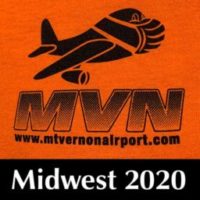 Lots of doubters expressed their opinions in the weeks and days before Mt. Vernon’s 12th running of this sector-specific event. Did it work? Were the naysayers right or wrong?
Lots of doubters expressed their opinions in the weeks and days before Mt. Vernon’s 12th running of this sector-specific event. Did it work? Were the naysayers right or wrong?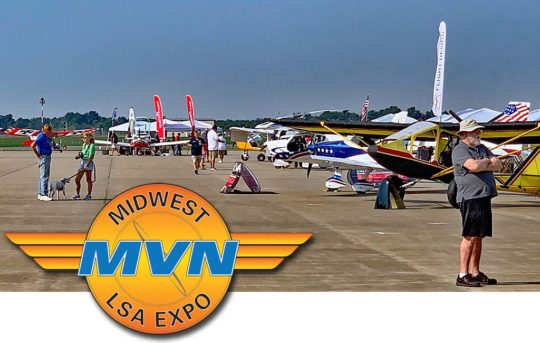 In a typical year, Midwest attracts 1,500 or more pilots for the three days of event. My casual estimate is that 2020 was at least as strong as before and perhaps it was even up a bit. No one knows more. Midwest does not charge a fee to enter and more than one entry gate would make any effort to count heads futile. So, admittedly, I am guessing but having been to 11 of the 12 events (I missed one due to a hurricane in Florida where I live), I think it was at least the same and possibly better than earlier years.
In a typical year, Midwest attracts 1,500 or more pilots for the three days of event. My casual estimate is that 2020 was at least as strong as before and perhaps it was even up a bit. No one knows more. Midwest does not charge a fee to enter and more than one entry gate would make any effort to count heads futile. So, admittedly, I am guessing but having been to 11 of the 12 events (I missed one due to a hurricane in Florida where I live), I think it was at least the same and possibly better than earlier years.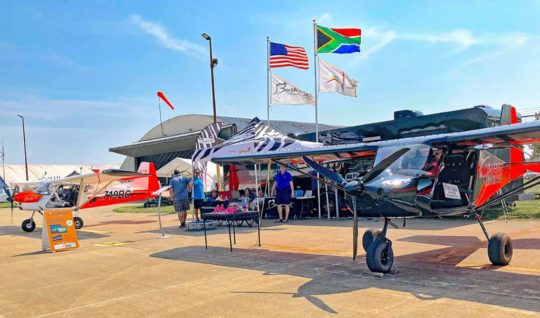
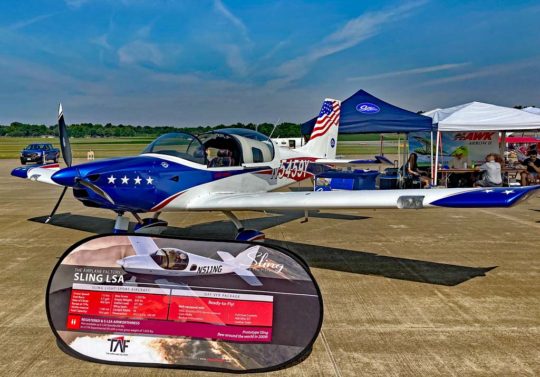 Some were told by their home state authorities that if they left they might not be allowed back in the state (presumably without some caution like mandatory quarantine). While this may seem like government overreach to many, employees who would not be traveling also stated concerns about getting exposed by those who did travel. Hit with both worries, some companies backed out.
Some were told by their home state authorities that if they left they might not be allowed back in the state (presumably without some caution like mandatory quarantine). While this may seem like government overreach to many, employees who would not be traveling also stated concerns about getting exposed by those who did travel. Hit with both worries, some companies backed out.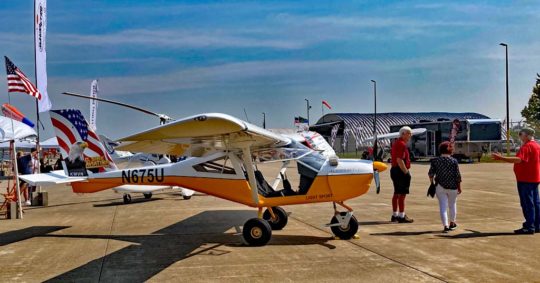 At least two more companies experienced serious weather between home and the show although Midwest 2020 enjoyed nearly perfect conditions. Plenty of demo flights attest to this. Several vendors filled their demo schedules.
At least two more companies experienced serious weather between home and the show although Midwest 2020 enjoyed nearly perfect conditions. Plenty of demo flights attest to this. Several vendors filled their demo schedules.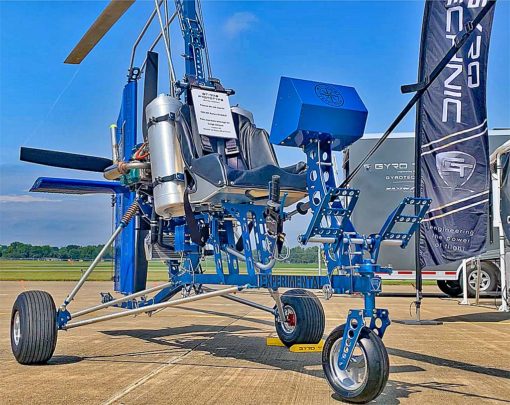 We have also seen a growth in interest in single seat aircraft… (example:
We have also seen a growth in interest in single seat aircraft… (example: 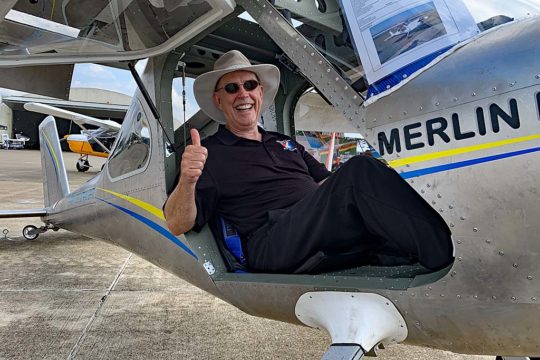 Developer Chip Erwin brought not only his fascinating aircraft but six sets of bathroom scales. Although these are not certified scales — an effort with such scales will happen shortly when the aircraft is fully complete — we checked them for consistency and we used all six scales in rotating positions. Four complete weighings produced numbers from 271.6 to 274.1 pounds. Using the allowed calculation for a whole-airframe parachute system, a Part 103 can weigh 278 pounds, suggesting Merlin Lite should comfortably qualify. Of course, speeds will also have to conform but Chip is very confident about the airplane staying Part 103 compliant. The weighed aircraft was not a stripped-down version but had most of the equipment on board that everyone will want. I’ll make a video of these steps as soon as possible, given very strong interest.
Developer Chip Erwin brought not only his fascinating aircraft but six sets of bathroom scales. Although these are not certified scales — an effort with such scales will happen shortly when the aircraft is fully complete — we checked them for consistency and we used all six scales in rotating positions. Four complete weighings produced numbers from 271.6 to 274.1 pounds. Using the allowed calculation for a whole-airframe parachute system, a Part 103 can weigh 278 pounds, suggesting Merlin Lite should comfortably qualify. Of course, speeds will also have to conform but Chip is very confident about the airplane staying Part 103 compliant. The weighed aircraft was not a stripped-down version but had most of the equipment on board that everyone will want. I’ll make a video of these steps as soon as possible, given very strong interest.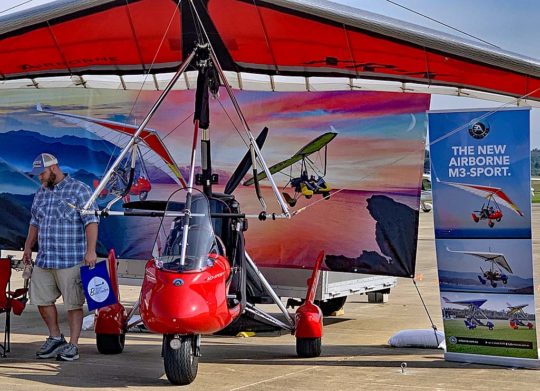 The first attendance at Midwest by
The first attendance at Midwest by 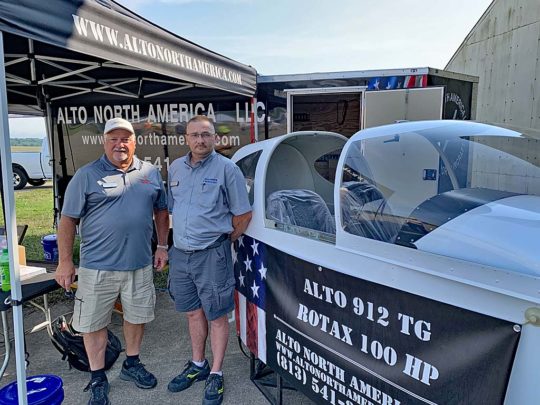
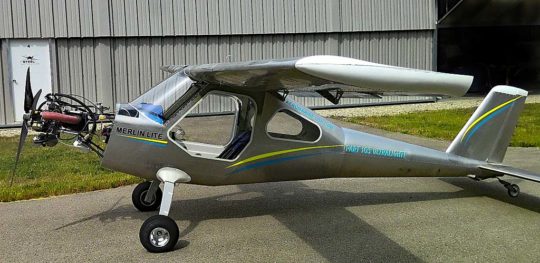 This method also made for an intriguing study in how America is coping with Covid. Near the freeways, at gas stops or hotels where tourists and travelers were present, masking was nearly universal. Few appeared to ignore store signs demanding a face covering.
This method also made for an intriguing study in how America is coping with Covid. Near the freeways, at gas stops or hotels where tourists and travelers were present, masking was nearly universal. Few appeared to ignore store signs demanding a face covering.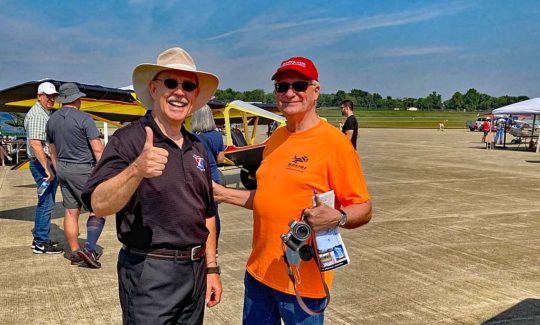
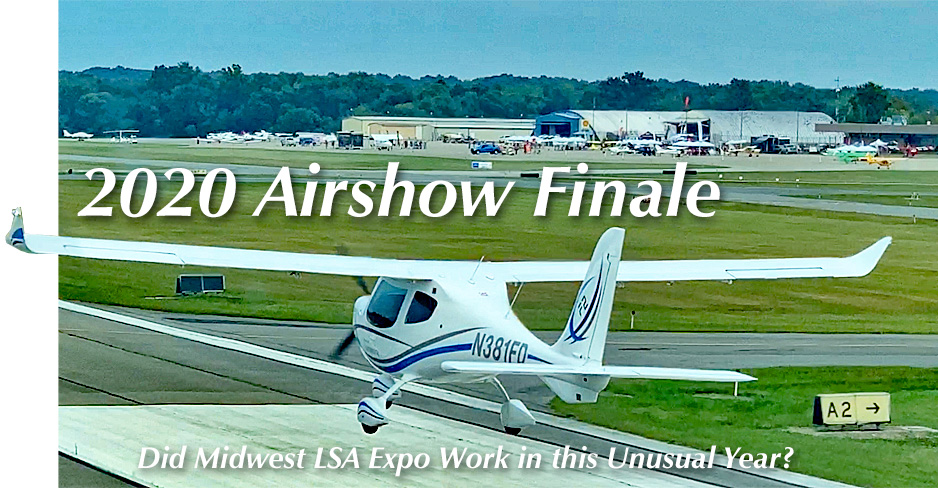
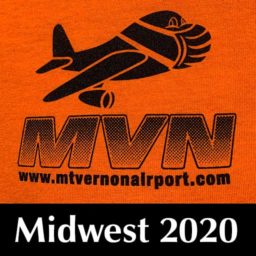 Another designer of very striking hardware is Larry Mednick of
Another designer of very striking hardware is Larry Mednick of 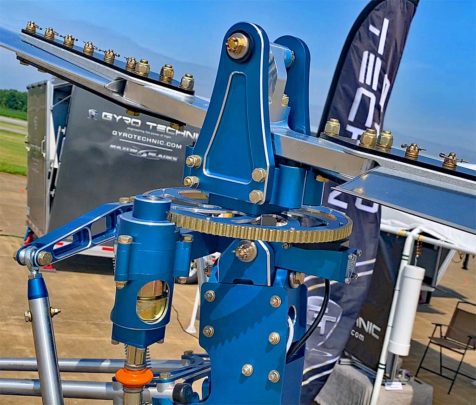 It has to do with the pod or cabin that most modern gyroplanes use. VX1 is an open cockpit design. All that fuselage area forward of CG needs more tail in the rear to offset the aerodynamic effects. Since VX1 has a fully open cockpit, it does not need the same tail displacement.
It has to do with the pod or cabin that most modern gyroplanes use. VX1 is an open cockpit design. All that fuselage area forward of CG needs more tail in the rear to offset the aerodynamic effects. Since VX1 has a fully open cockpit, it does not need the same tail displacement.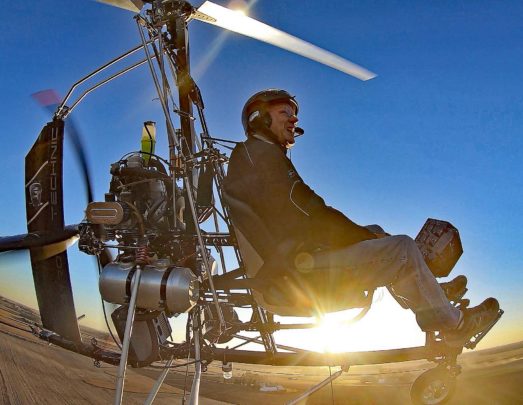 “A comfortable cruise speed is about 60 mph. Full fuel tanks (7.5 gallons) will then give you a range of 50+ miles with a safe fuel reserve.
“A comfortable cruise speed is about 60 mph. Full fuel tanks (7.5 gallons) will then give you a range of 50+ miles with a safe fuel reserve.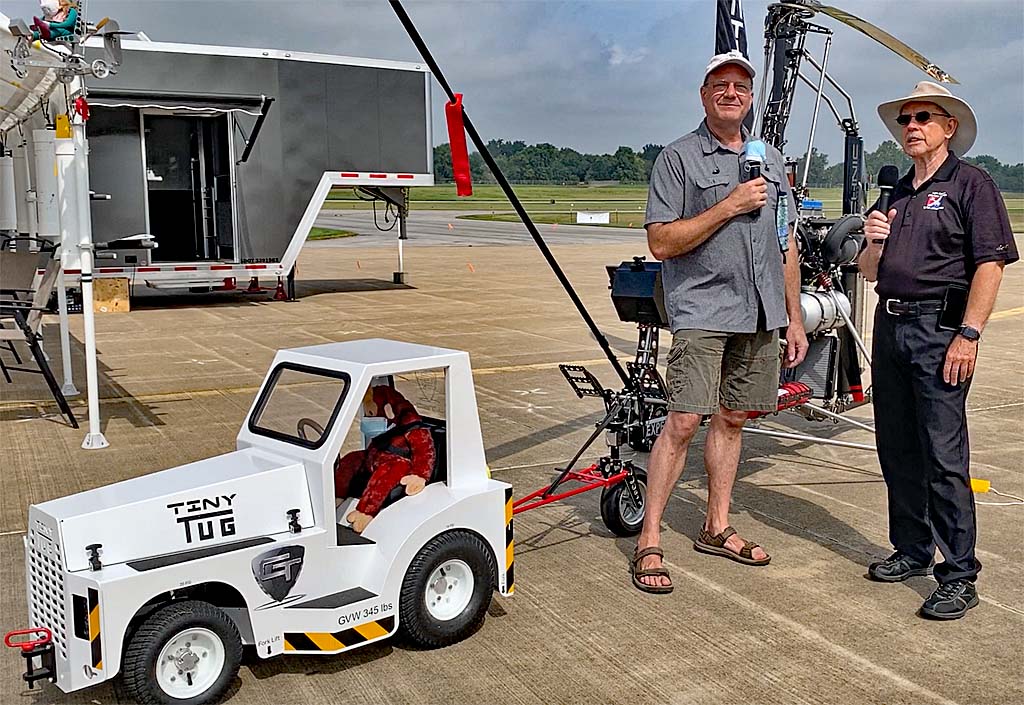
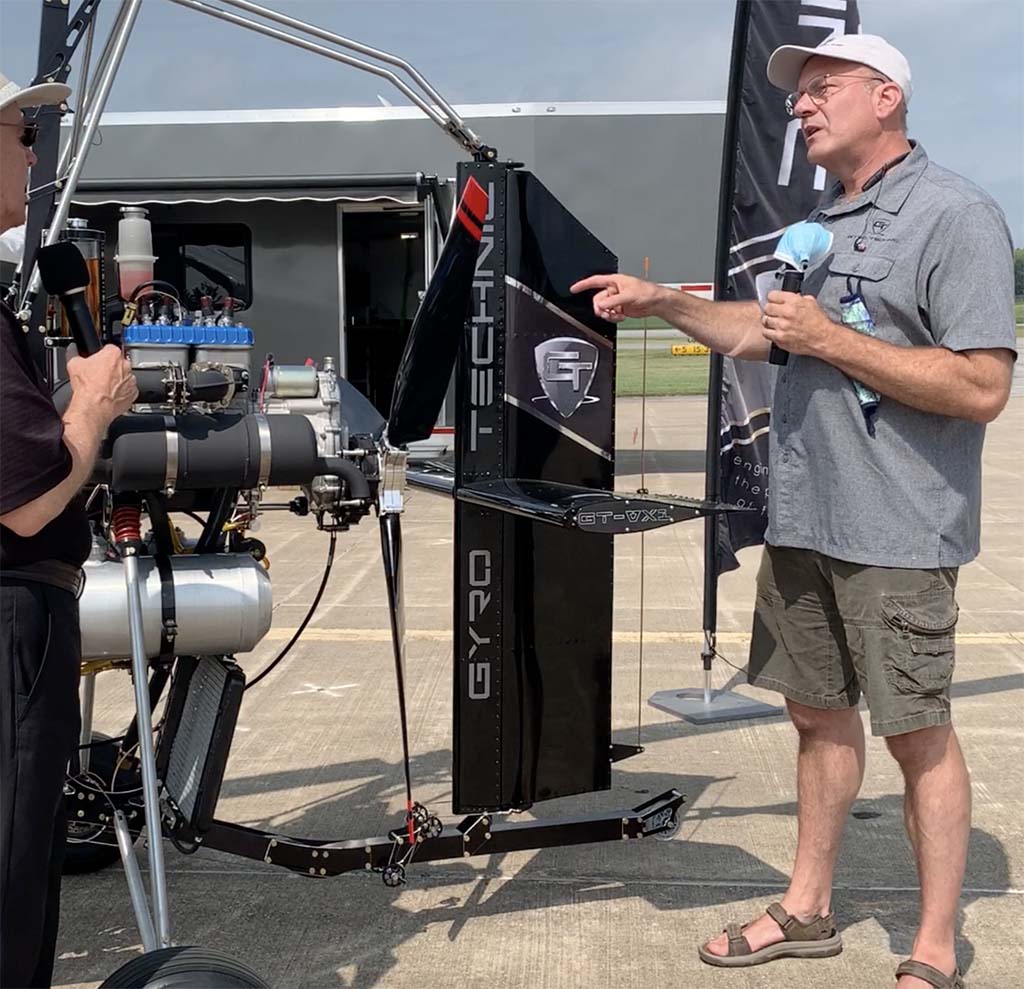
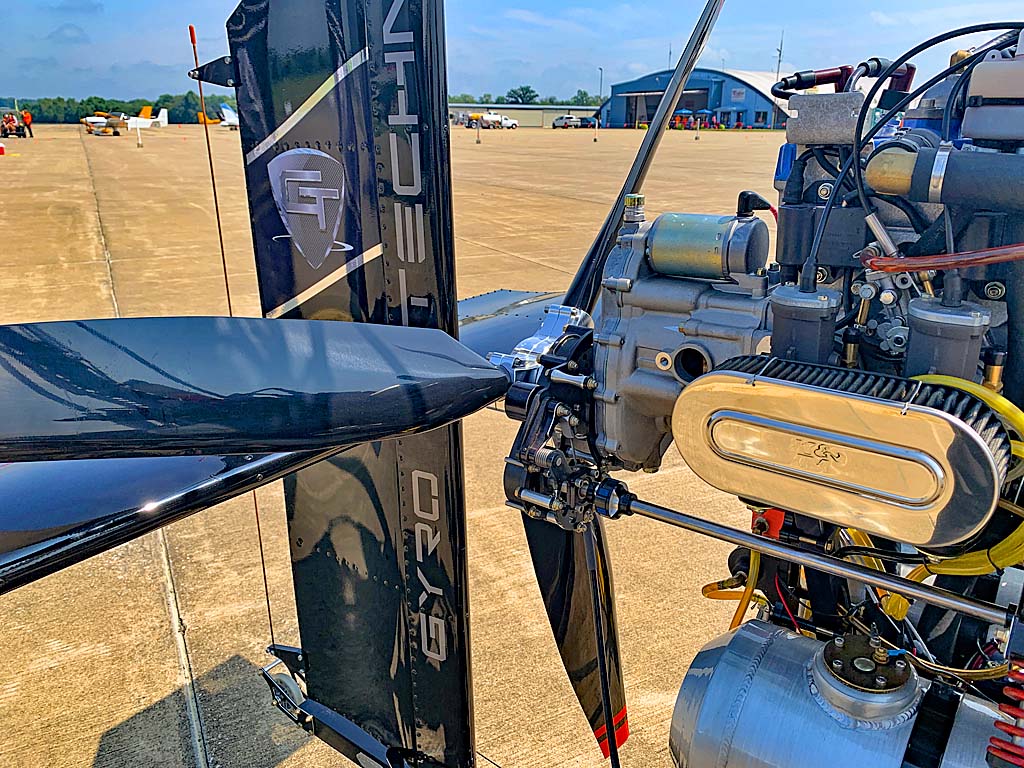
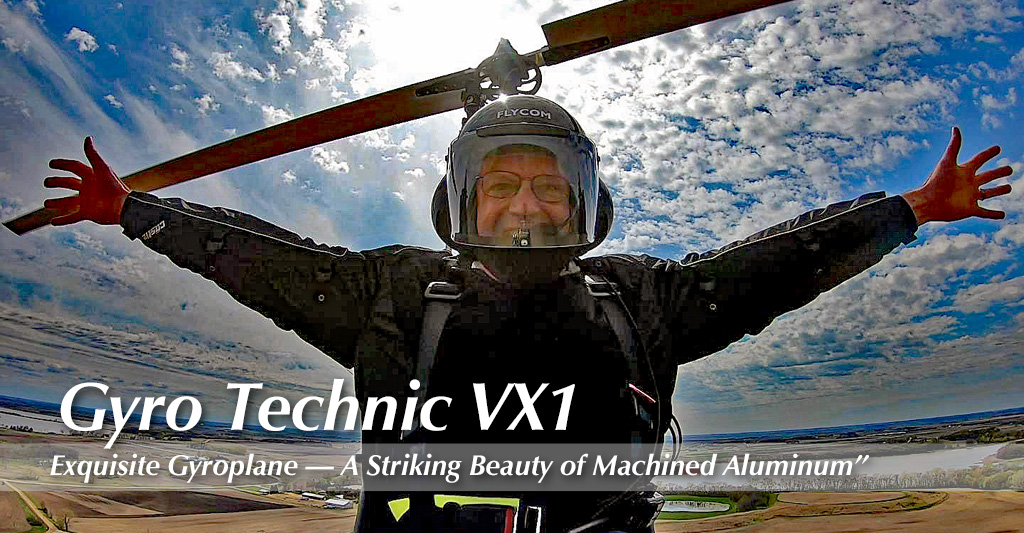
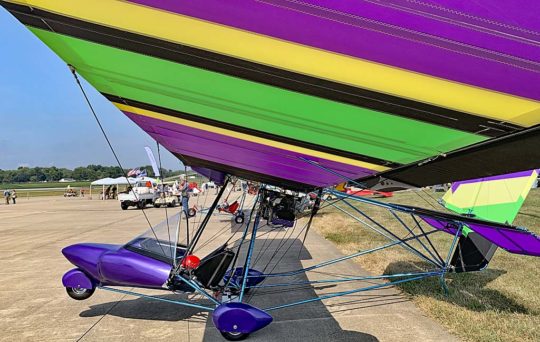 One proof among many, Mark Smith created an aftermarket steerable nose wheel system for Quicksilver aircraft before the factory developed their own. Multiple component changes purported to improve handling, performance, and durability.
One proof among many, Mark Smith created an aftermarket steerable nose wheel system for Quicksilver aircraft before the factory developed their own. Multiple component changes purported to improve handling, performance, and durability.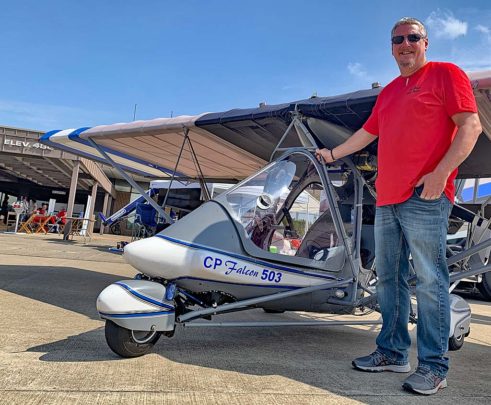 Smith wrote, “There were nearly 10,000 MX [Quicksilver models] sold over the years, with most of the models sharing many of the design features of the MX. There are many changes that make the plane fly better, handle better, steer better, handle wind and gusts better, and so on.”
Smith wrote, “There were nearly 10,000 MX [Quicksilver models] sold over the years, with most of the models sharing many of the design features of the MX. There are many changes that make the plane fly better, handle better, steer better, handle wind and gusts better, and so on.”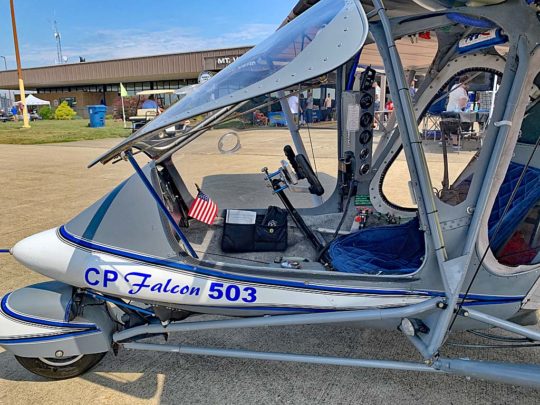 Those parts are but a few of many alterations the Mark Smith enterprise has created over many years of serving the Quicksilver market. Created to make the airplanes fly faster, handle better and last longer, they also streamline the aircraft, give it distinctive looks, and enhance strength in ways big and small.
Those parts are but a few of many alterations the Mark Smith enterprise has created over many years of serving the Quicksilver market. Created to make the airplanes fly faster, handle better and last longer, they also streamline the aircraft, give it distinctive looks, and enhance strength in ways big and small.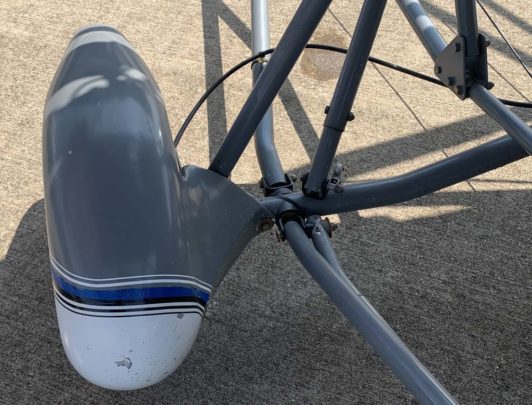 Except for engine, tires, wheels, and brakes, Tri-State makes every component that goes on the Smithsilvers. They even sew their own wing coverings, assembled from sturdy Dacron sailcloth. Sewing of wings (or sails) is a specialized craft. I have experience with hang glider wings (more complex than you think) and I was quite impressed with the detail and precision shown on their wings displayed at Midwest LSA Expo 2020.
Except for engine, tires, wheels, and brakes, Tri-State makes every component that goes on the Smithsilvers. They even sew their own wing coverings, assembled from sturdy Dacron sailcloth. Sewing of wings (or sails) is a specialized craft. I have experience with hang glider wings (more complex than you think) and I was quite impressed with the detail and precision shown on their wings displayed at Midwest LSA Expo 2020.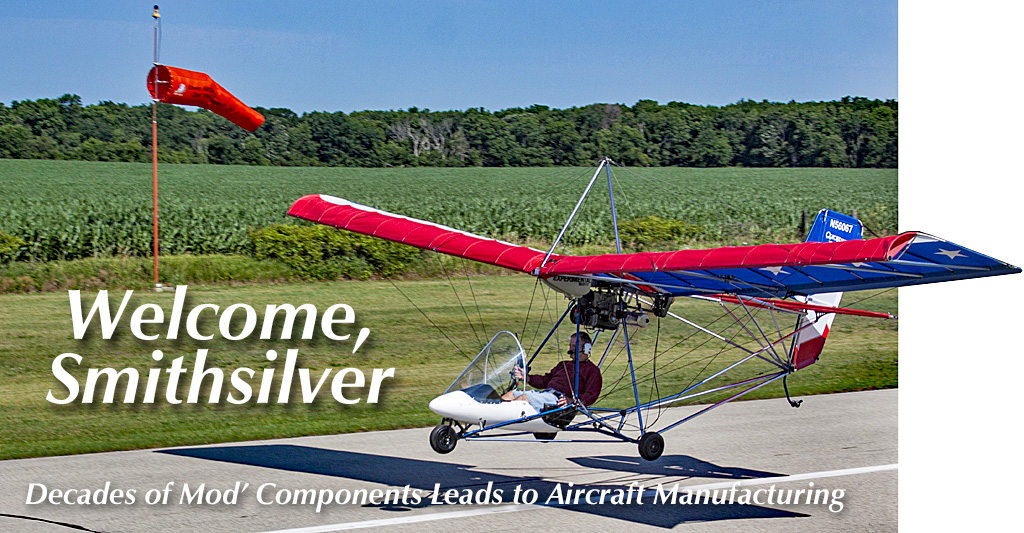
 Longtime journalist Tim Kern — of
Longtime journalist Tim Kern — of 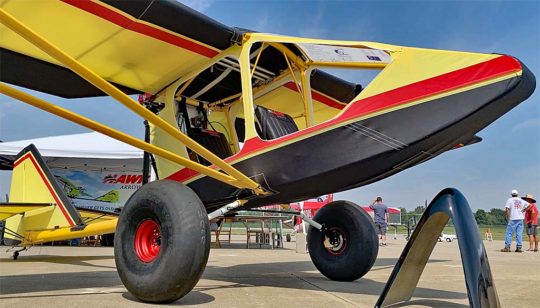 At Midwest 2020, I interviewed Joseph Shirley, boss of
At Midwest 2020, I interviewed Joseph Shirley, boss of 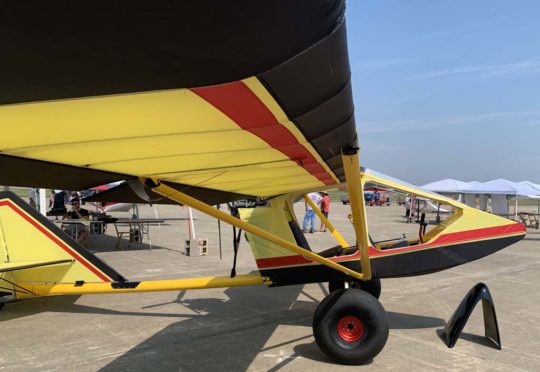 Joseph reported that his team has transferred all drawings, including some engineering drawings and other simple hand drawings from the old days, turning them into SolidWorks CAD drawings. This will help assure a higher state of quality to all parts and components but it also helps kit builders by providing major improvements to the build manual, a task most talented designers find to be one of the hardest parts of creating a kit aircraft.
Joseph reported that his team has transferred all drawings, including some engineering drawings and other simple hand drawings from the old days, turning them into SolidWorks CAD drawings. This will help assure a higher state of quality to all parts and components but it also helps kit builders by providing major improvements to the build manual, a task most talented designers find to be one of the hardest parts of creating a kit aircraft.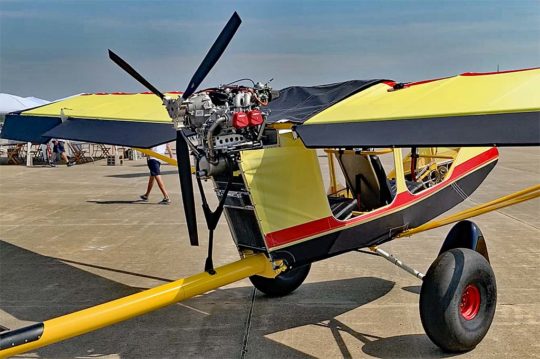 I never thought of Hawk as a bush aircraft. It’s history as a simple ultralight from the early 1980s suggested it was a more fair weather flyer …not that there’s anything wrong with that, of course.
I never thought of Hawk as a bush aircraft. It’s history as a simple ultralight from the early 1980s suggested it was a more fair weather flyer …not that there’s anything wrong with that, of course.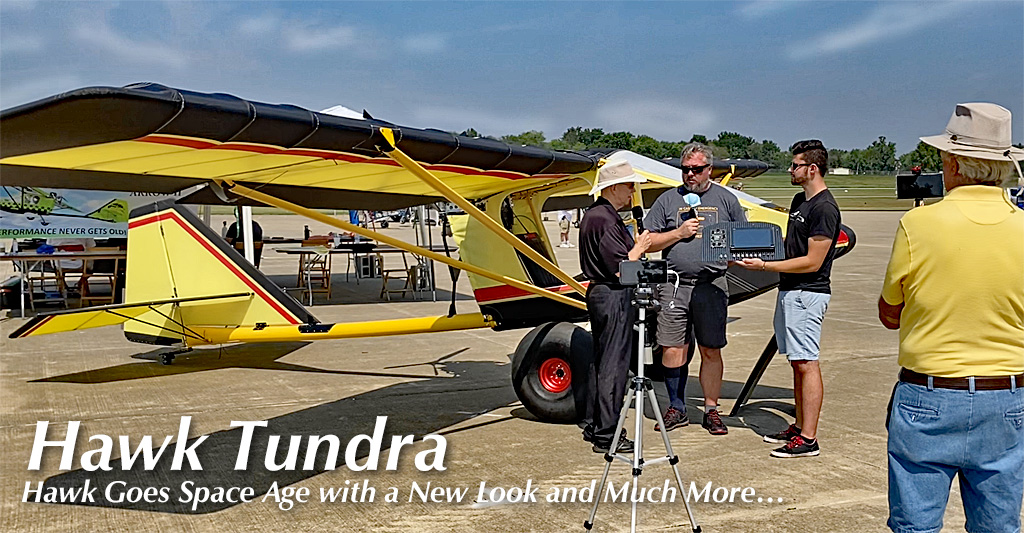
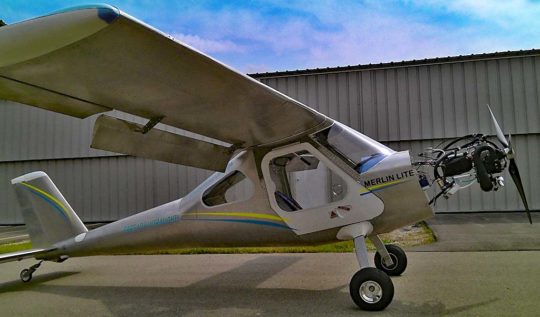 However, such “alternative aircraft” may not be what you had in mind. Many are open cockpit and pilots trained in a Cessna or Piper can feel uneasy being out in the open (even if behind a pod and windscreen). Also, weight shift trikes, powered parachutes, or gyroplanes handle differently from stick (or yoke) and rudder.
However, such “alternative aircraft” may not be what you had in mind. Many are open cockpit and pilots trained in a Cessna or Piper can feel uneasy being out in the open (even if behind a pod and windscreen). Also, weight shift trikes, powered parachutes, or gyroplanes handle differently from stick (or yoke) and rudder.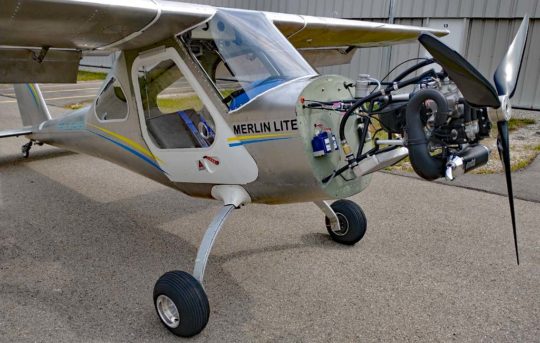 Chip believes his new Part 103 “magic” ultralight is truly revolutionary.
Chip believes his new Part 103 “magic” ultralight is truly revolutionary.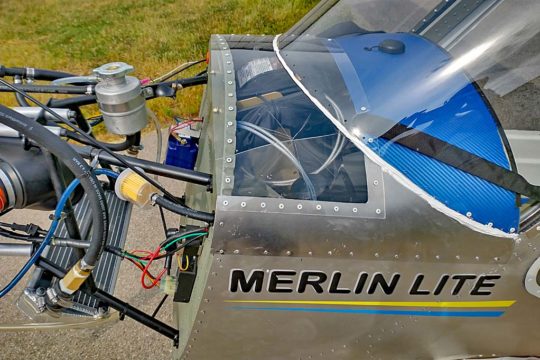 “Based on Merlin PSA, a popular single seat personal sport aircraft that costs less than $40,000 and cruises at 120 mph, Merlin Lite’s cockpit is almost as large as the Merlin’s, but the powerplant is scaled down and the 3-D tapered wing aspect ratio is increased,” said Chip.
“Based on Merlin PSA, a popular single seat personal sport aircraft that costs less than $40,000 and cruises at 120 mph, Merlin Lite’s cockpit is almost as large as the Merlin’s, but the powerplant is scaled down and the 3-D tapered wing aspect ratio is increased,” said Chip.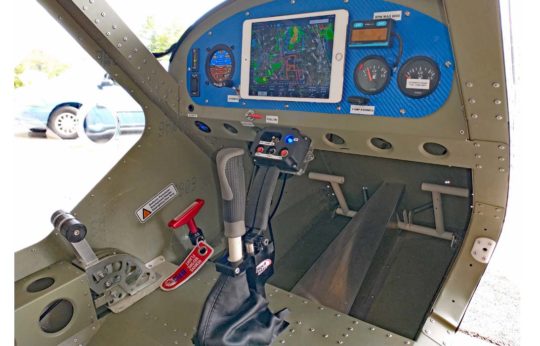
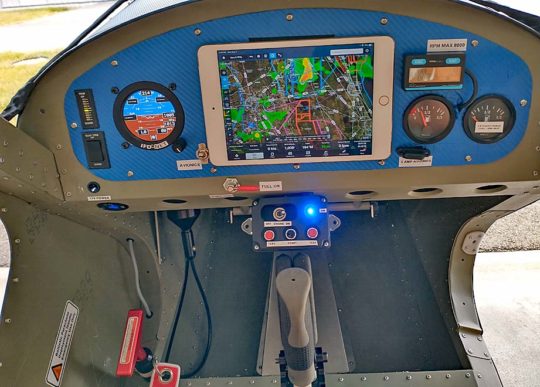 Merlin Lite finished and ready-to-fly — $31,000 equipped with electric-starting
Merlin Lite finished and ready-to-fly — $31,000 equipped with electric-starting 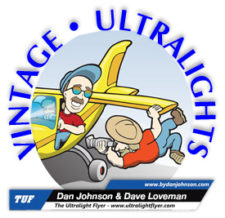 To find truly affordable aircraft, for one example, search for “vintage ultralights” you will be lead to our April 2020 series on ten super-affordable airplanes, all of which are available second hand for less than $10,000. You may not know that Search can be more specific. After you use Search, a page shows you whatever is found but you can drill down further — click “Try our advanced search option.”
To find truly affordable aircraft, for one example, search for “vintage ultralights” you will be lead to our April 2020 series on ten super-affordable airplanes, all of which are available second hand for less than $10,000. You may not know that Search can be more specific. After you use Search, a page shows you whatever is found but you can drill down further — click “Try our advanced search option.”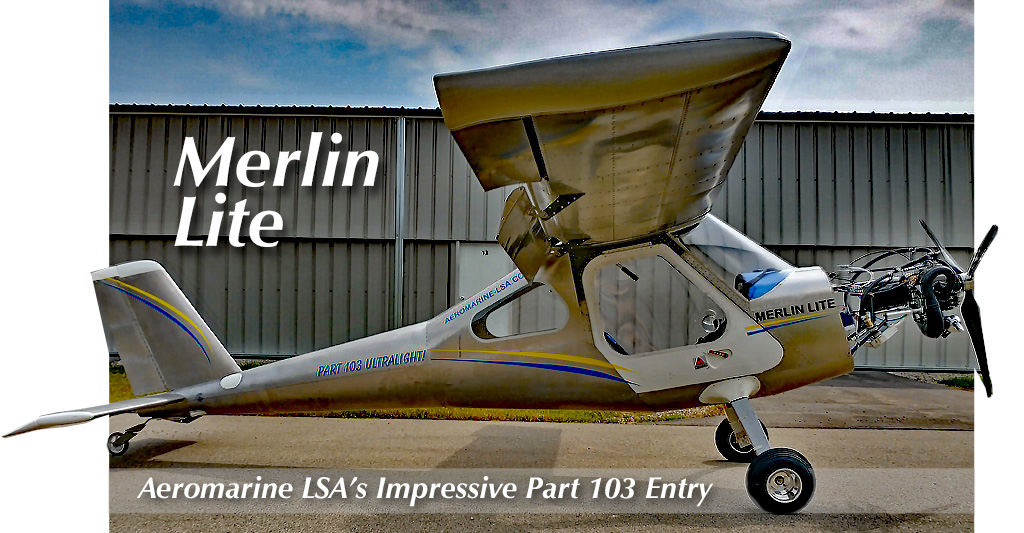
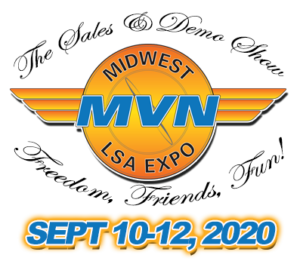 I hope you can attend 2020’s
I hope you can attend 2020’s 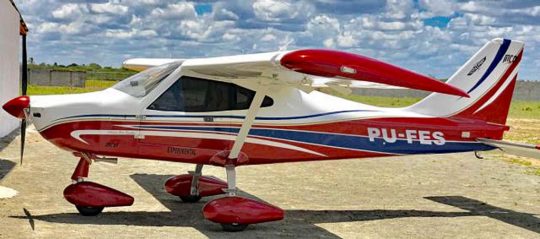 MC-01 by Montaer
MC-01 by Montaer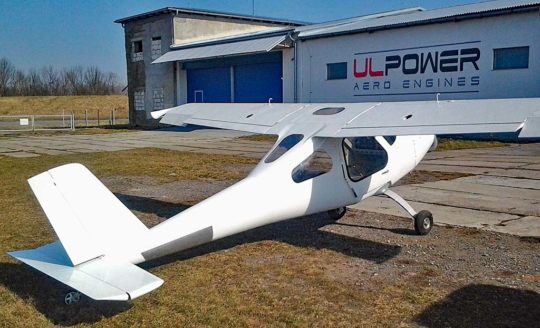
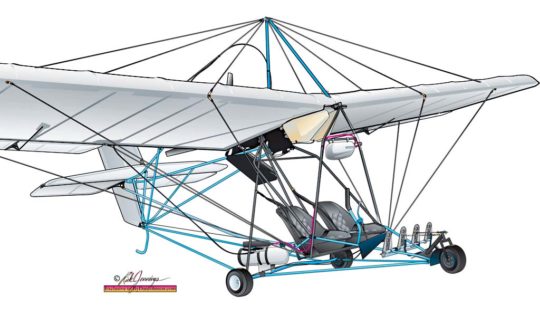 SmithSilver by Tri-State Kite
SmithSilver by Tri-State Kite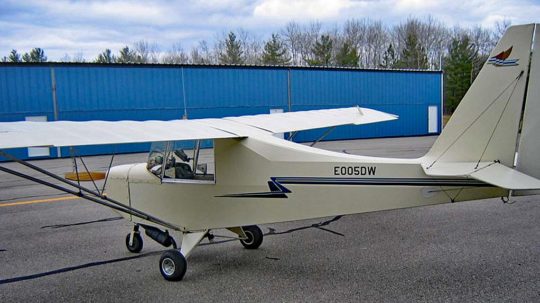 Sparrow by Carlson
Sparrow by Carlson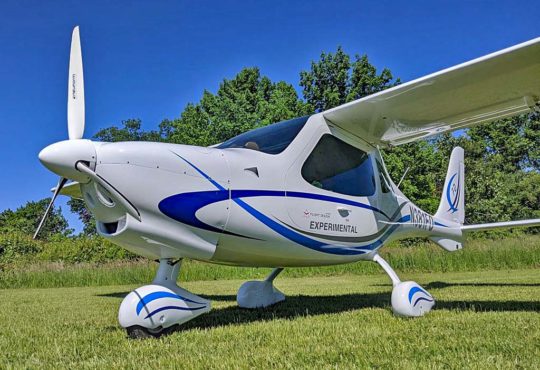 F2 by Flight Design
F2 by Flight Design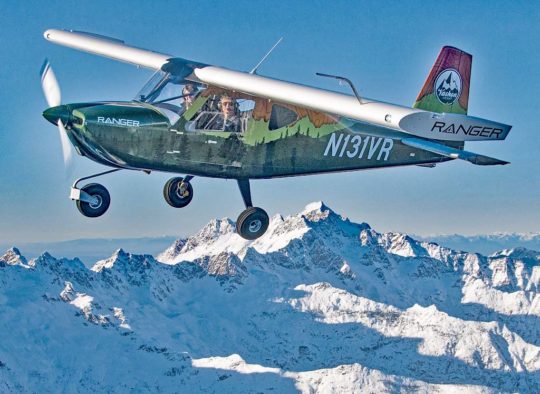 Vashon Ranger
Vashon Ranger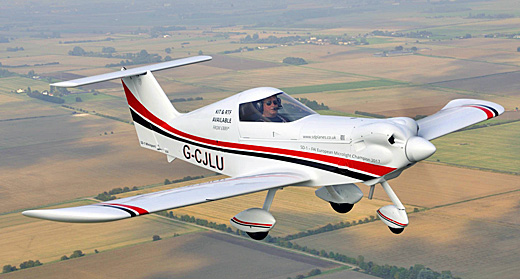
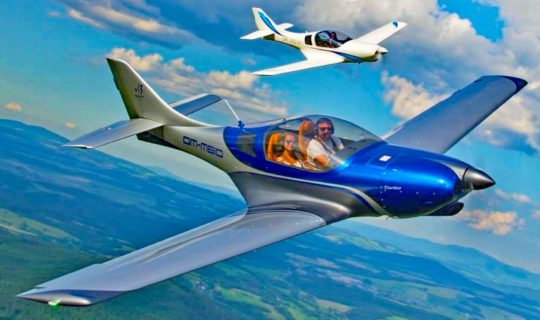 VL3 by JMB Aircraft
VL3 by JMB Aircraft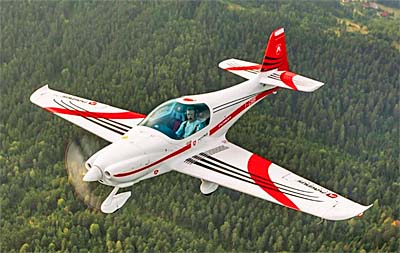 Fusion 212 by Magnus
Fusion 212 by Magnus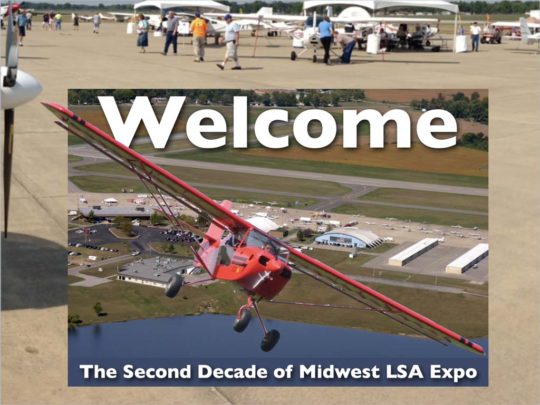 Rob Rollison the proprietor of the very successful
Rob Rollison the proprietor of the very successful 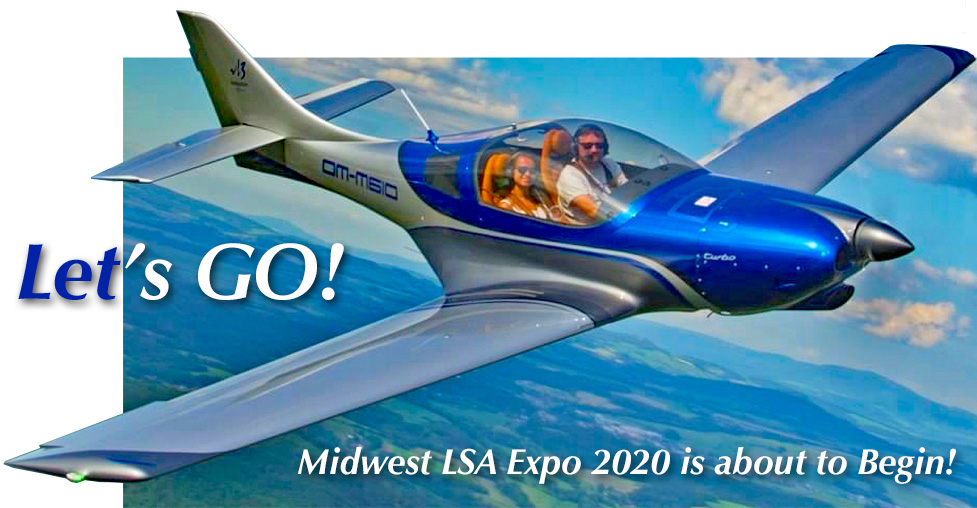
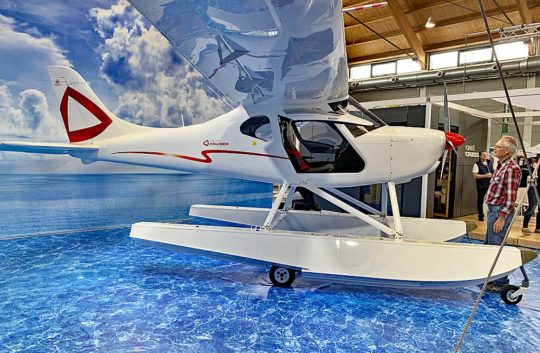 Some of you may feel the same, I suspect. I don’t suggest you need to go to them all, but if people who do what I do don’t have airshows to attend, you get less cool news about great aircraft and flight gear.
Some of you may feel the same, I suspect. I don’t suggest you need to go to them all, but if people who do what I do don’t have airshows to attend, you get less cool news about great aircraft and flight gear.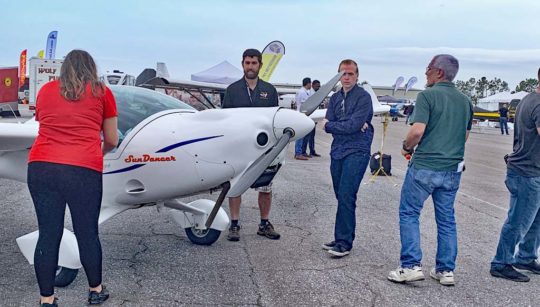 I think these shows setting dates in the new year is a great and wonderful thing.
I think these shows setting dates in the new year is a great and wonderful thing.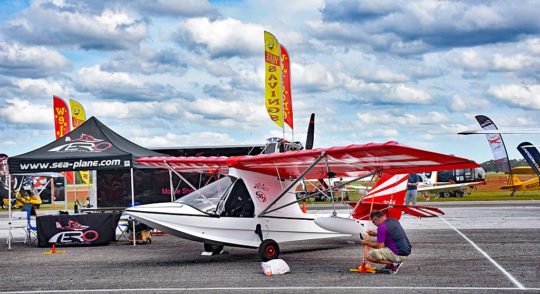 “We are now happy to confirm January 28-30, 2021 as the new event date for the fifth annual DeLand Sport Aviation Showcase,” Jana added. Most readers will recall the 15-year-old Sebring Expo used similar January dates. That event ended after the
“We are now happy to confirm January 28-30, 2021 as the new event date for the fifth annual DeLand Sport Aviation Showcase,” Jana added. Most readers will recall the 15-year-old Sebring Expo used similar January dates. That event ended after the 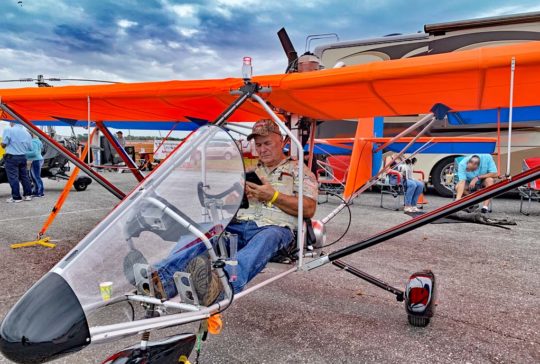 Yes, after having to cancel Aero 2020 and
Yes, after having to cancel Aero 2020 and 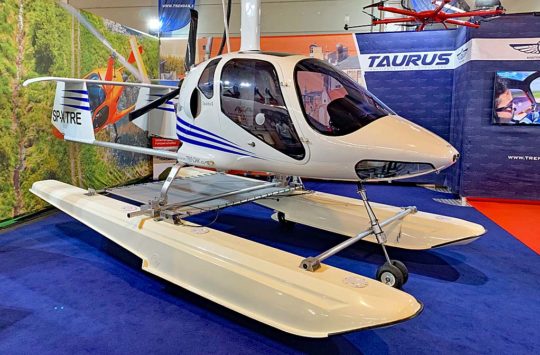 Yes, the new Aero dates are April 21-24, 2021. Whew! With Sun ‘n Fun slated for April 13-18, 2021, that gives a couple days of breathing room between these two important events …time to pack new clothes, clean photos off my devices, and repack for Europe. What a relief!
Yes, the new Aero dates are April 21-24, 2021. Whew! With Sun ‘n Fun slated for April 13-18, 2021, that gives a couple days of breathing room between these two important events …time to pack new clothes, clean photos off my devices, and repack for Europe. What a relief! While I’m ecstatic about the Sun ‘n Fun and Aero 2021 timing, in only a few more days, I leave for Mt. Vernon, Illinois, home to the
While I’m ecstatic about the Sun ‘n Fun and Aero 2021 timing, in only a few more days, I leave for Mt. Vernon, Illinois, home to the 
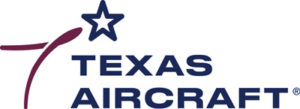 I always enjoy when a new airplane company arrives on the market and sets plans in motion to expand and improve their flying machine. Texas Aircraft and their Colt 100 Light-Sport Aircraft is one such company.
I always enjoy when a new airplane company arrives on the market and sets plans in motion to expand and improve their flying machine. Texas Aircraft and their Colt 100 Light-Sport Aircraft is one such company.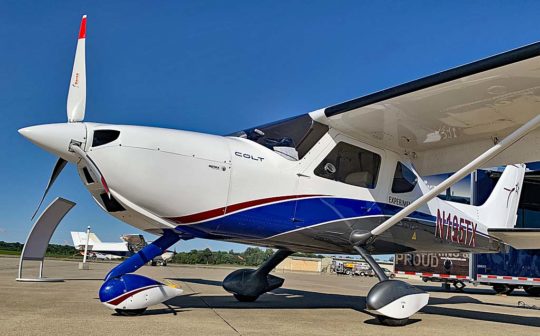 Rather than repeat what
Rather than repeat what 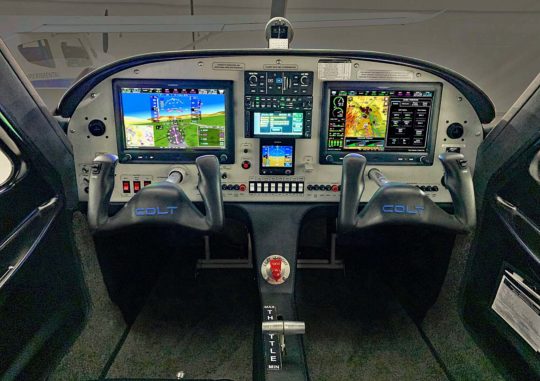 Texas Aircraft announced, “The addition of the
Texas Aircraft announced, “The addition of the 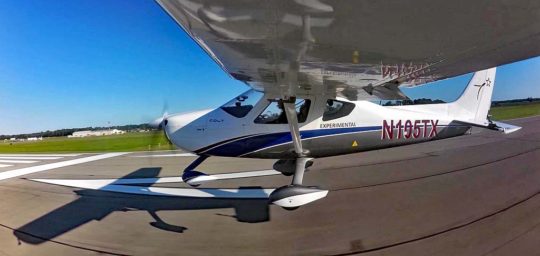 Scott explained that while the Colt’s standard Dynon avionics package is TAA compliant and amazing for flight training, “flight schools are asking for Garmin.” Providing Garmin equipment can help reduce the time and cost associated with training students on multiple avionics systems as they progress.
Scott explained that while the Colt’s standard Dynon avionics package is TAA compliant and amazing for flight training, “flight schools are asking for Garmin.” Providing Garmin equipment can help reduce the time and cost associated with training students on multiple avionics systems as they progress.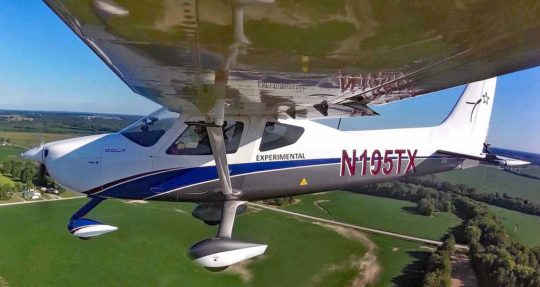 “We are now offering Garmin-equipped Colt aircraft with the basic VFR package starting at $139,000,” said Scott. The fully-equipped, “Heavy IFR” Garmin package is priced starting at $170,500 (see below).
“We are now offering Garmin-equipped Colt aircraft with the basic VFR package starting at $139,000,” said Scott. The fully-equipped, “Heavy IFR” Garmin package is priced starting at $170,500 (see below).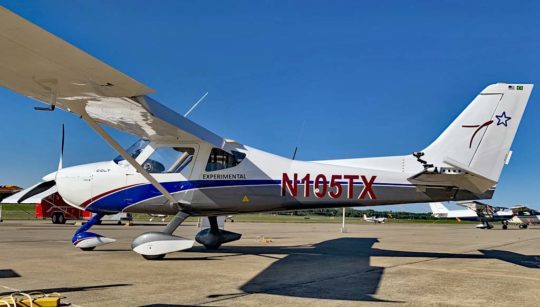 Almost everyone knows at least some facts about batteries. Everything we carry around these days seems battery powered and all of us are ever in search of an electric outlet to get more charge. Until battery energy density takes a substantial leap forward, electric airplanes have some clear limitations. Yet primary flight instruction — at least done in the pattern within easy reach of landing back on the field — is one early potential for electric powered LSA.
Almost everyone knows at least some facts about batteries. Everything we carry around these days seems battery powered and all of us are ever in search of an electric outlet to get more charge. Until battery energy density takes a substantial leap forward, electric airplanes have some clear limitations. Yet primary flight instruction — at least done in the pattern within easy reach of landing back on the field — is one early potential for electric powered LSA.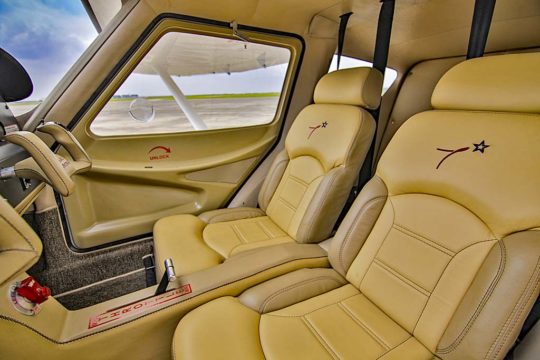 Huw Hampson-Jones, CEO of Oxis Energy, said, “Oxis Li-S technology offers significant benefits to aviation. The use of sulfur as a non-conductive material provides enhanced safety and is superior to current Lithium-Ion technology. Our 90kWh battery system is 40% lighter than current Li-Ion technology and will be powered by its ‘High Power’ cell at 400Wh/kg.”
Huw Hampson-Jones, CEO of Oxis Energy, said, “Oxis Li-S technology offers significant benefits to aviation. The use of sulfur as a non-conductive material provides enhanced safety and is superior to current Lithium-Ion technology. Our 90kWh battery system is 40% lighter than current Li-Ion technology and will be powered by its ‘High Power’ cell at 400Wh/kg.”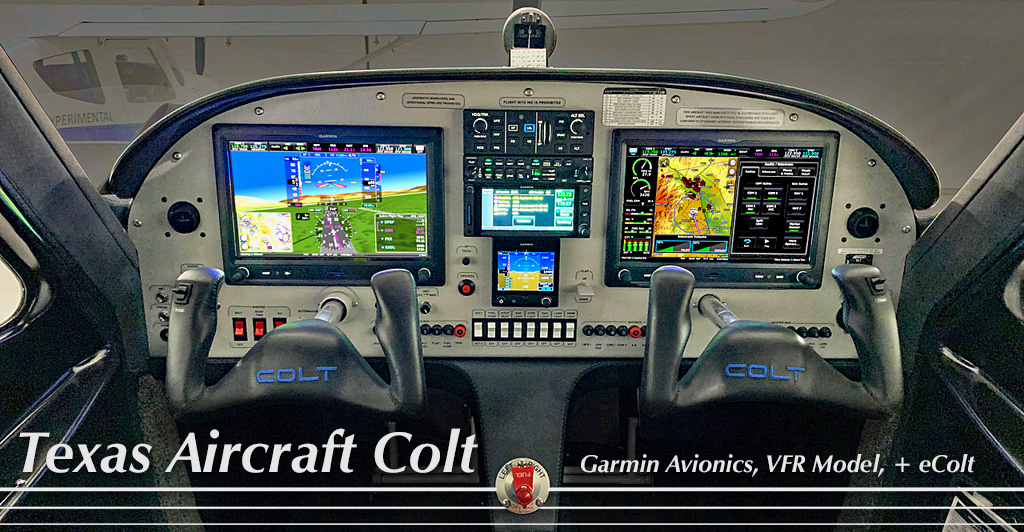
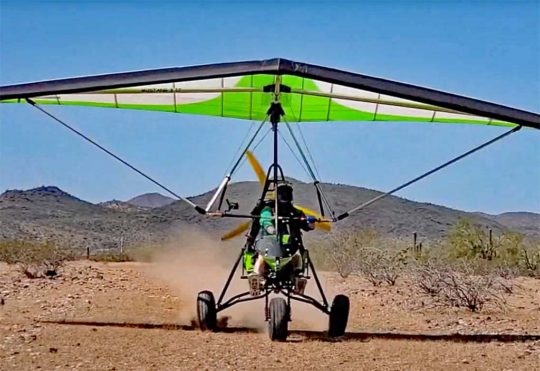 Denny has an enviable position to some. Imagine any fixed wing instructor saying, “I wish the aircraft would do some operations differently for my teaching. I can’t find one that exactly matches what I seek, so, you know what? I’ll just design what I want.”
Denny has an enviable position to some. Imagine any fixed wing instructor saying, “I wish the aircraft would do some operations differently for my teaching. I can’t find one that exactly matches what I seek, so, you know what? I’ll just design what I want.”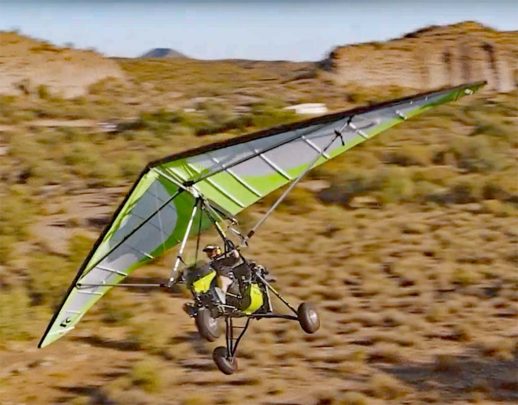 To make the airplane fit the terrain Denny wanted to access — creek beds, desert landscapes, mountainous terrain and more — he knew he needed a very durable, strong, and well-performing trike.
To make the airplane fit the terrain Denny wanted to access — creek beds, desert landscapes, mountainous terrain and more — he knew he needed a very durable, strong, and well-performing trike.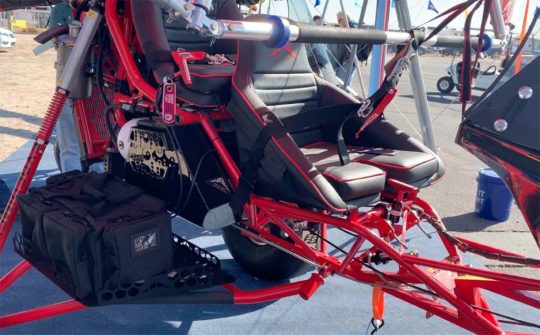 “When you chase strength and when you chase simple, you get ugly,” observed philosophical trike designer Denny Reed with a smile on his face. “When we first showed it, I was real proud of it but one of the first comments we got was, ‘It looks like a post-war Russian tractor.'” Denny laughed aloud as he related the story.
“When you chase strength and when you chase simple, you get ugly,” observed philosophical trike designer Denny Reed with a smile on his face. “When we first showed it, I was real proud of it but one of the first comments we got was, ‘It looks like a post-war Russian tractor.'” Denny laughed aloud as he related the story.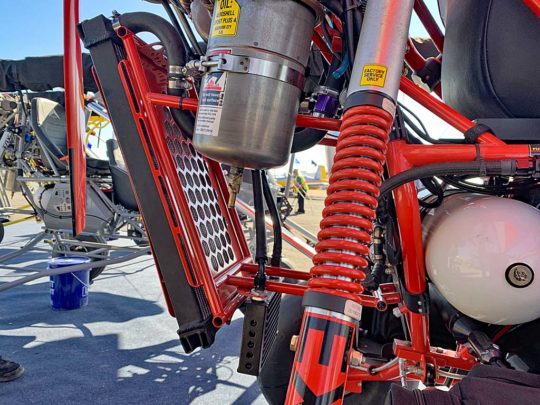 The entire frame is welded chrome moly with a ceramic coating.
The entire frame is welded chrome moly with a ceramic coating.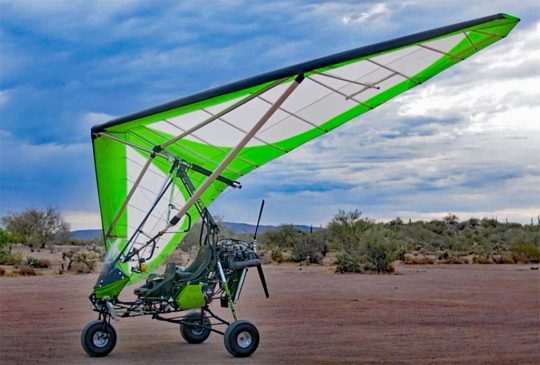 Prices start at $36,500 (in summer 2020; subject to change). Of course, you can spend more, but with that modest starting cost for this tougher-than-nails trike, Goat qualifies as an “affordable aircraft” as this website promotes. (Of course, “affordable” means something different to every single pilot, but at about the cost of an average new car, I’d say this was a very fair asking price.)
Prices start at $36,500 (in summer 2020; subject to change). Of course, you can spend more, but with that modest starting cost for this tougher-than-nails trike, Goat qualifies as an “affordable aircraft” as this website promotes. (Of course, “affordable” means something different to every single pilot, but at about the cost of an average new car, I’d say this was a very fair asking price.) 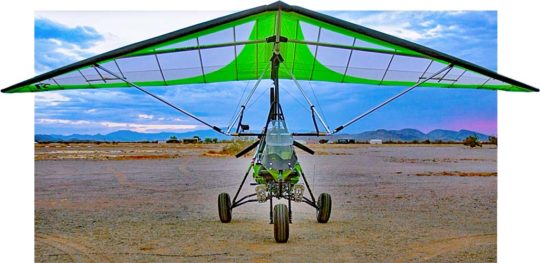 “I enjoy teaching,” Denny said, returning to what is obviously a favorite topic after he described details of how he builds Goat.
“I enjoy teaching,” Denny said, returning to what is obviously a favorite topic after he described details of how he builds Goat.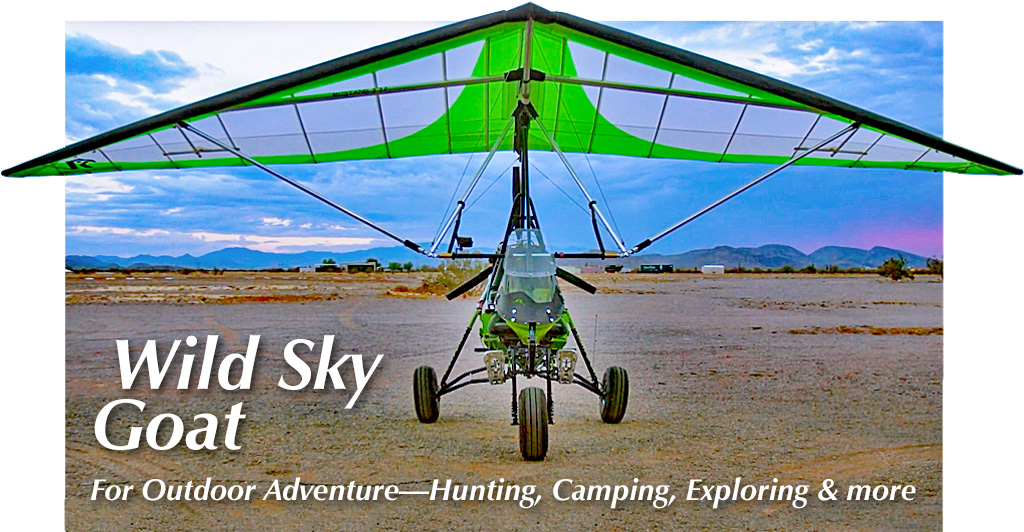
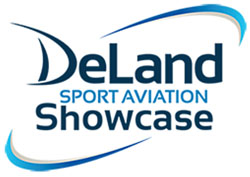 The founding administrator, Jana Filip, made the official announcement, “The 2020 DeLand Sport Aviation Showcase is being rescheduled due to the ongoing Covid-19 pandemic.”
The founding administrator, Jana Filip, made the official announcement, “The 2020 DeLand Sport Aviation Showcase is being rescheduled due to the ongoing Covid-19 pandemic.”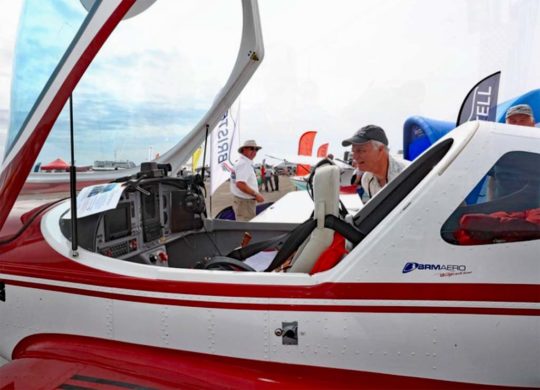
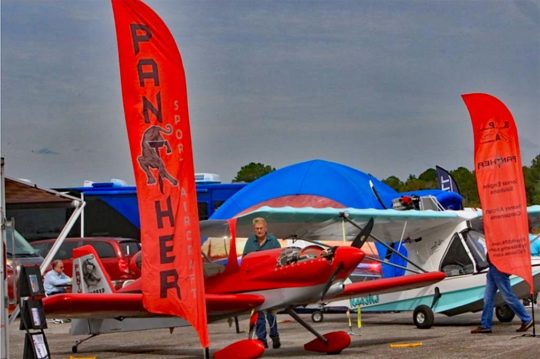 “DeLand Showcase is but the most recent aviation event to have to give way to such concerns,” Jana stated.
“DeLand Showcase is but the most recent aviation event to have to give way to such concerns,” Jana stated.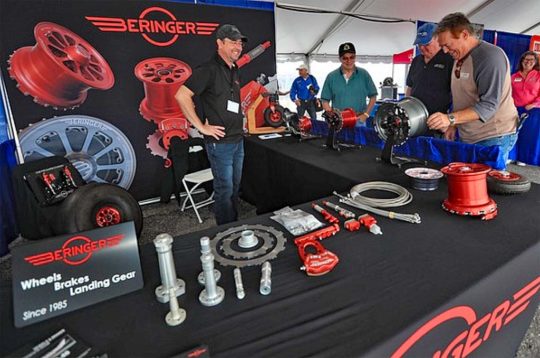
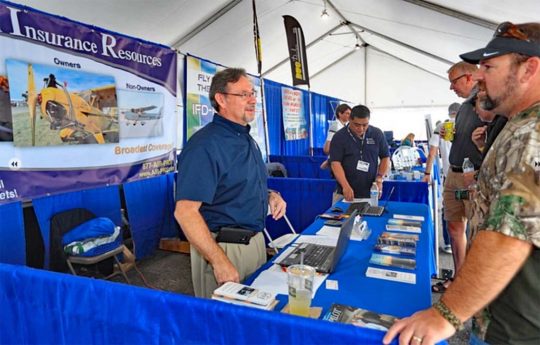
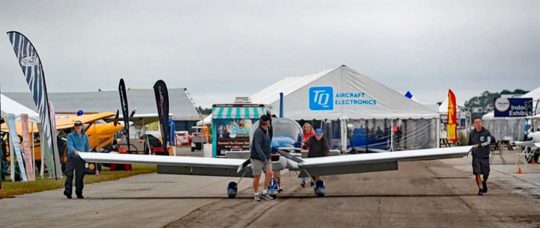 DSAS staff promised an update “as soon as more data is available.”
DSAS staff promised an update “as soon as more data is available.”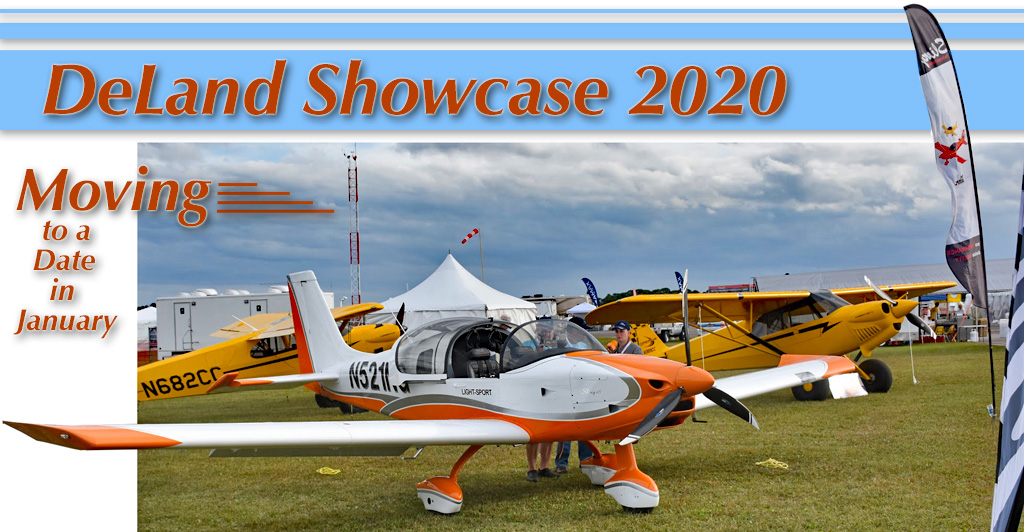
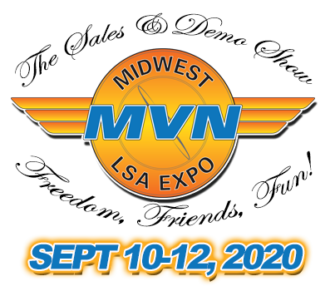 For 2020, the next airshow is Mt. Vernon Airport’s (KMVN)
For 2020, the next airshow is Mt. Vernon Airport’s (KMVN) 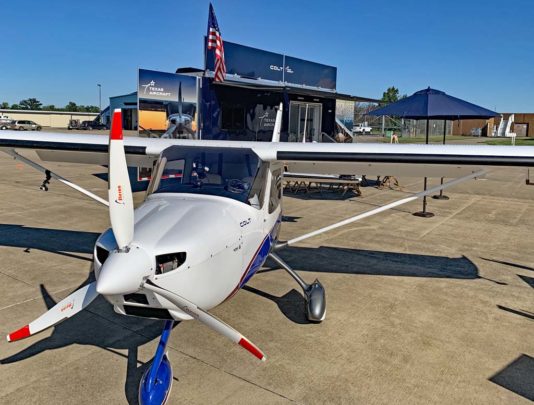
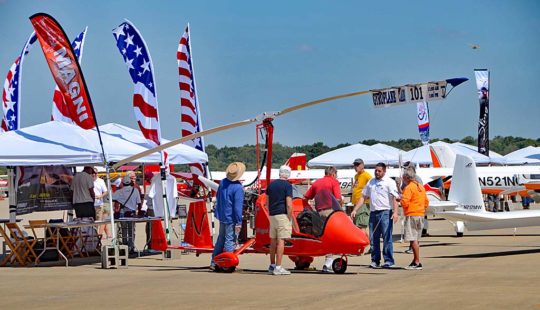
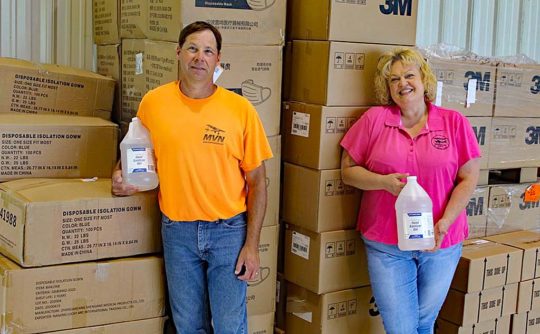
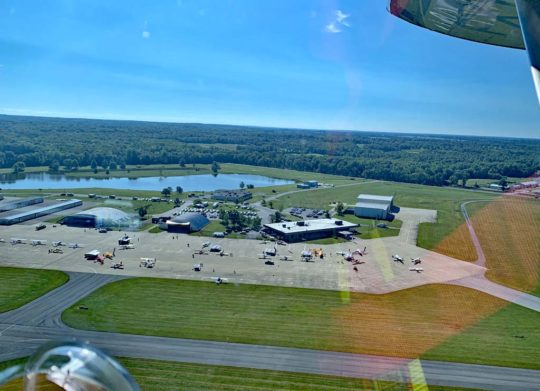
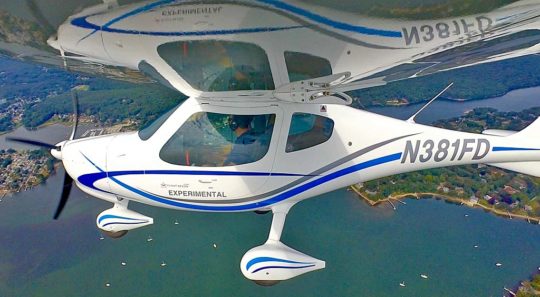
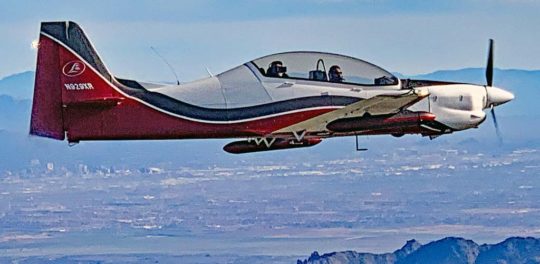
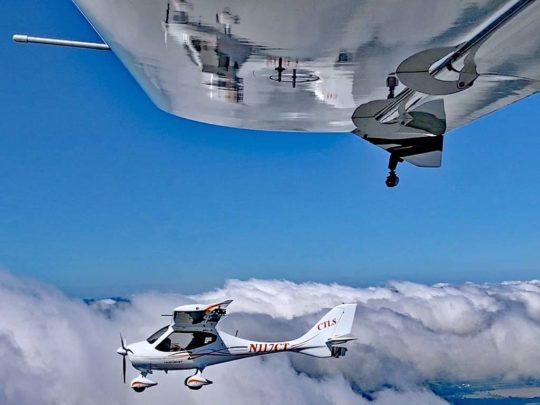
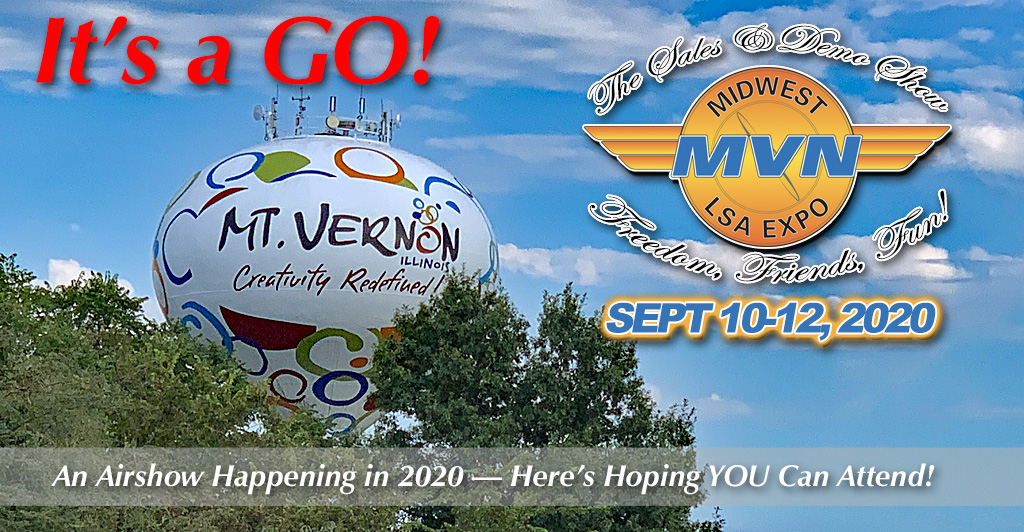

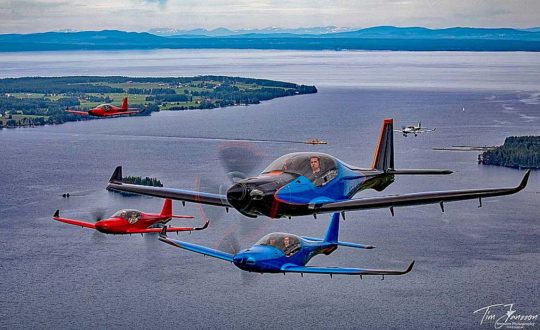 “We have also planned demo tours in Germany.
“We have also planned demo tours in Germany. 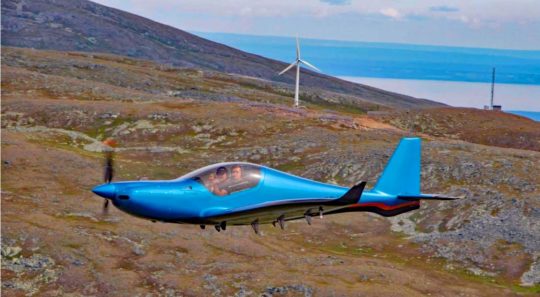 Meanwhile, “The 915iS model is getting close to 35 hours of test flights. We are doing testing at outside temperatures above 30 degrees celsius (86°F) to make sure the installation also works well in hot climates.”
Meanwhile, “The 915iS model is getting close to 35 hours of test flights. We are doing testing at outside temperatures above 30 degrees celsius (86°F) to make sure the installation also works well in hot climates.”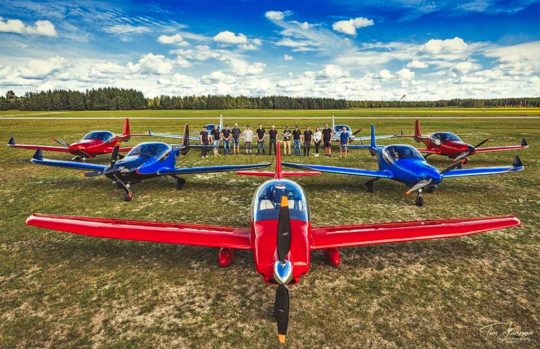
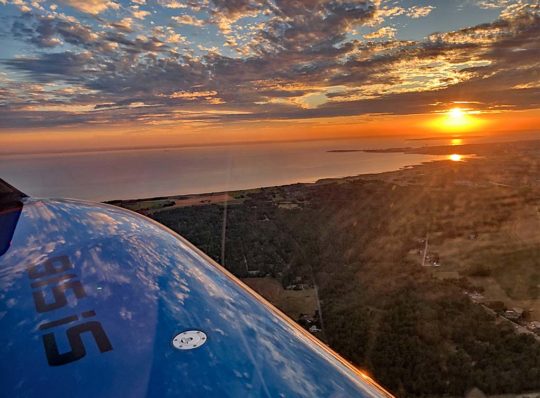
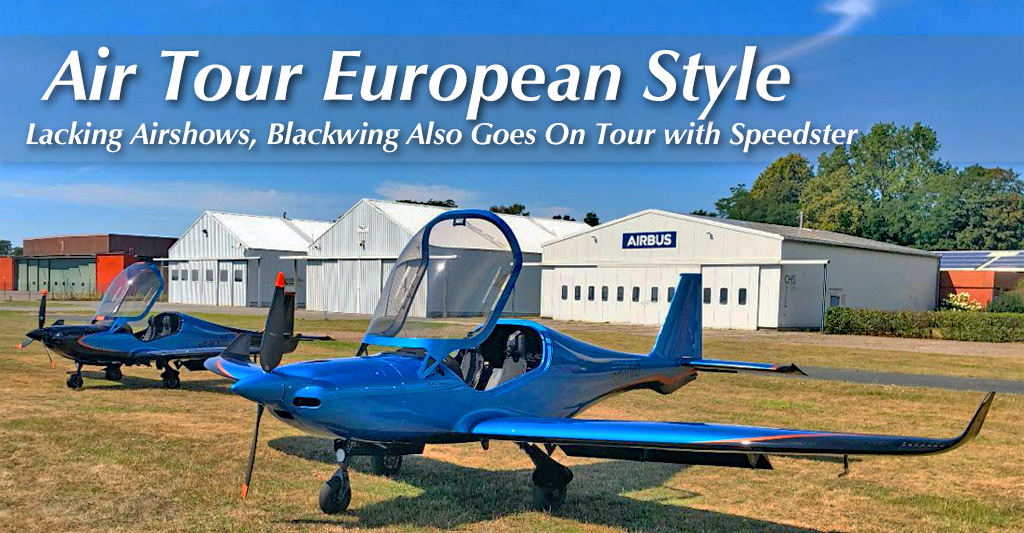
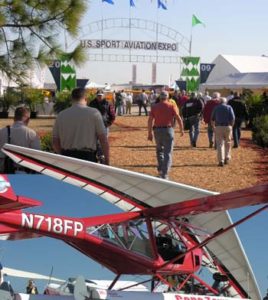 Although a mirror reflection of the greater global economy, many pilots are stunned that airshow after airshow has fallen to the virus. It seems like two or three years ago when, back in February 2020, Videoman Dave and I covered the
Although a mirror reflection of the greater global economy, many pilots are stunned that airshow after airshow has fallen to the virus. It seems like two or three years ago when, back in February 2020, Videoman Dave and I covered the 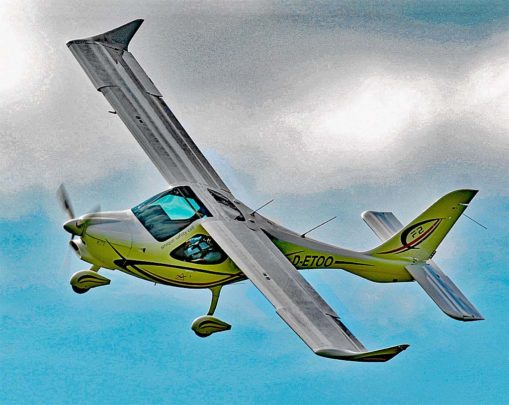 Tom has run
Tom has run 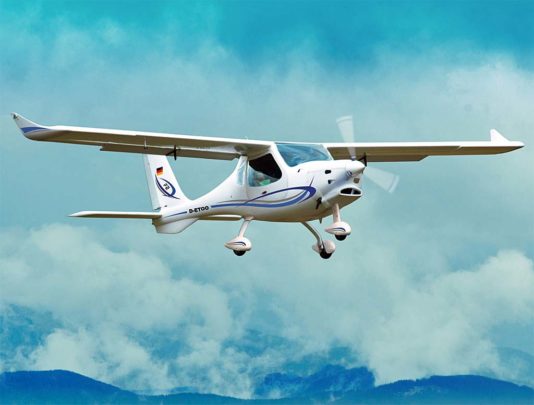 “I’m very impressed with F2. It feels like a bigger airplane, very solid in the air. More stable than I expected. Very easy to land.” He’s comparing to the CTLS that so many other pilots know.
“I’m very impressed with F2. It feels like a bigger airplane, very solid in the air. More stable than I expected. Very easy to land.” He’s comparing to the CTLS that so many other pilots know.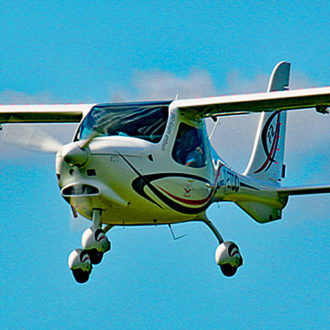 In one of the nearby photos taken from the nose of F2, the vertical surface of the tailplane appears enormous, one to rival the very tall tail on an
In one of the nearby photos taken from the nose of F2, the vertical surface of the tailplane appears enormous, one to rival the very tall tail on an 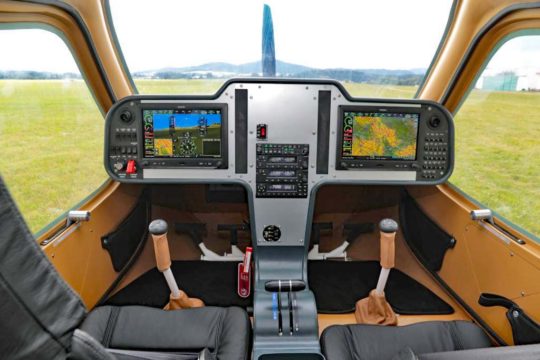
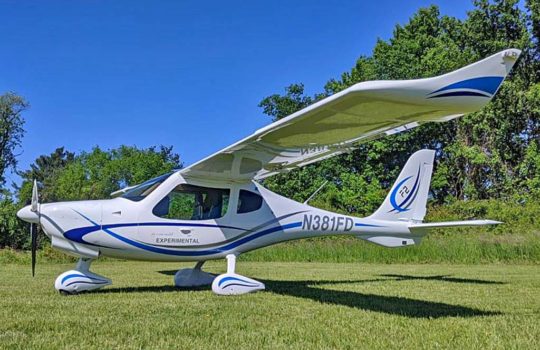
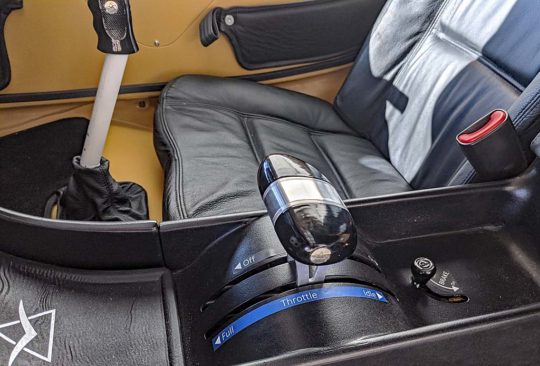
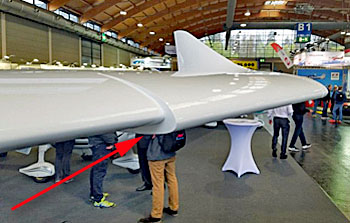 As we discussed the two planes, Tom said he thought I could do the same maneuvers with F2 that I’d done with the Icon A5 and I’d get a similar sensation.
As we discussed the two planes, Tom said he thought I could do the same maneuvers with F2 that I’d done with the Icon A5 and I’d get a similar sensation.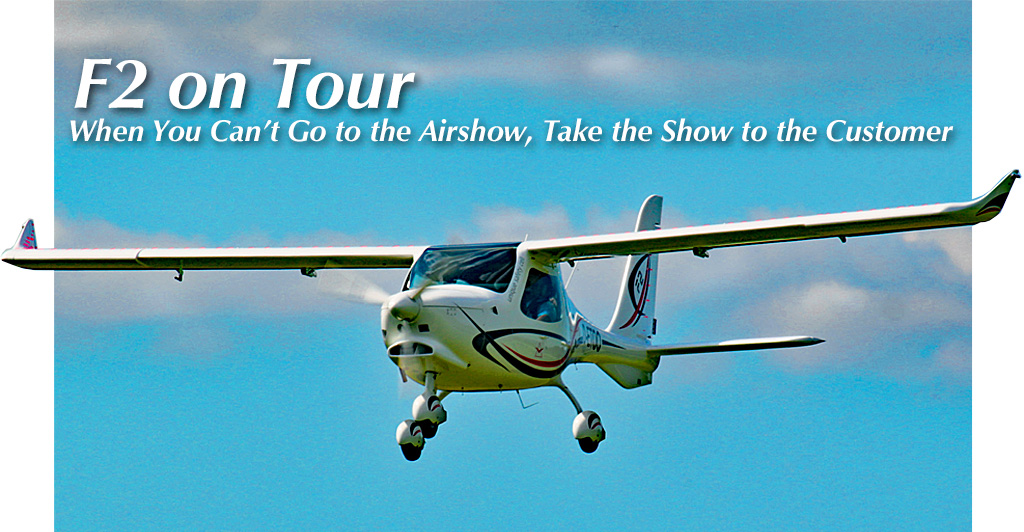

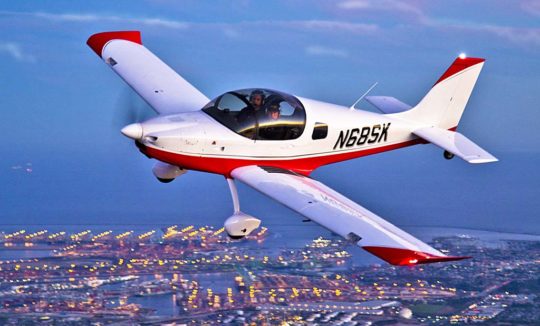
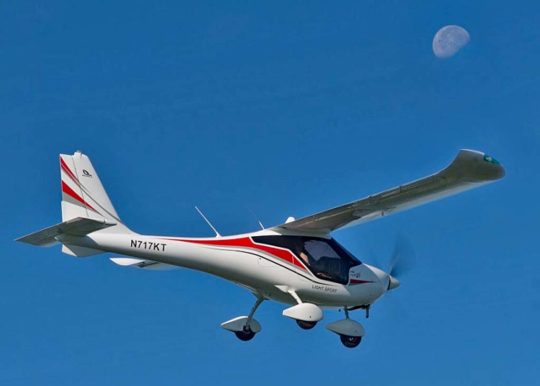
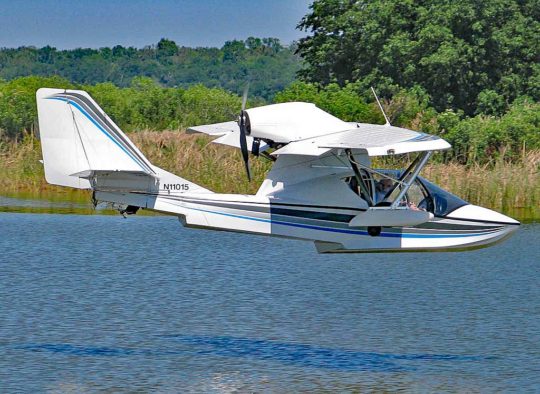
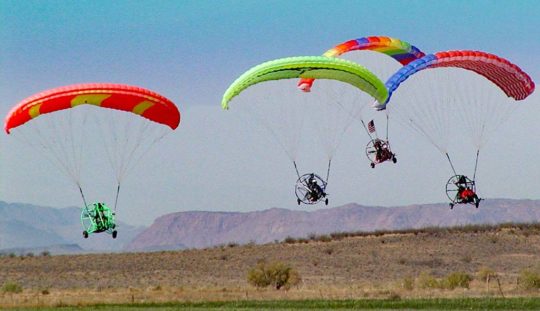
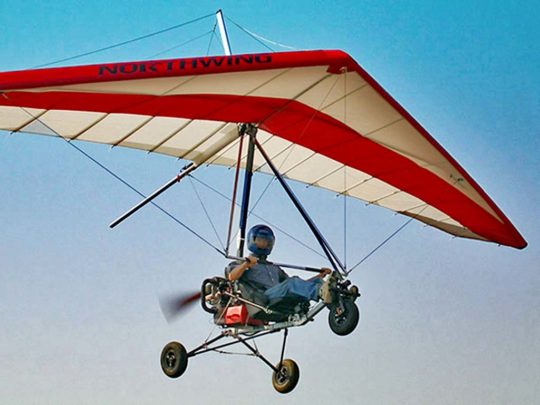
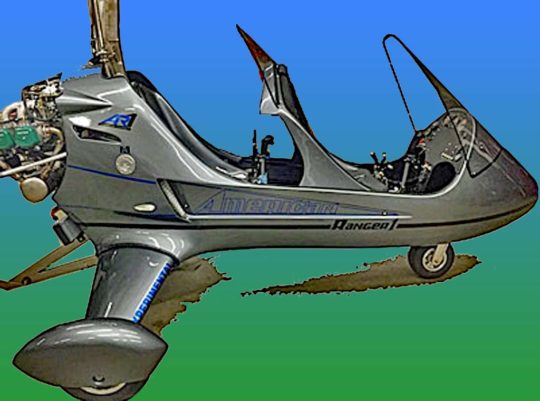
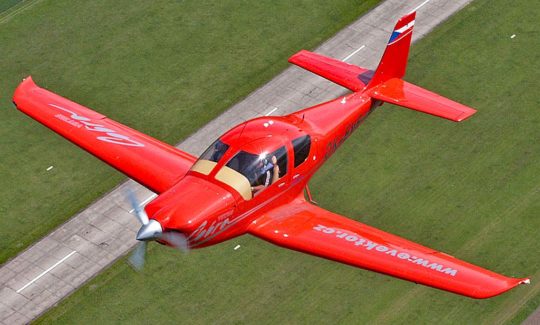
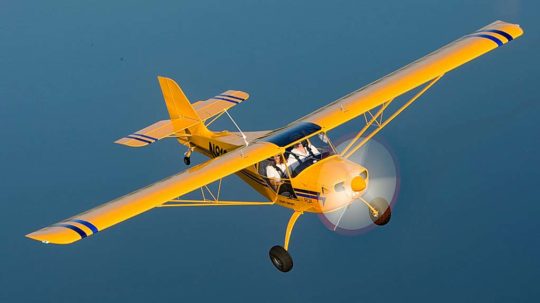
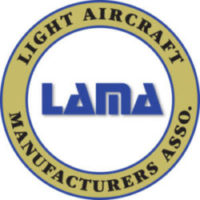 FAA representatives from both Aircraft Certification and Flight Standards have confirmed that — while nothing is certain at this time and that many more people inside the agency must have an opportunity to provide their expertise — all the requests by LAMA remain in consideration.
FAA representatives from both Aircraft Certification and Flight Standards have confirmed that — while nothing is certain at this time and that many more people inside the agency must have an opportunity to provide their expertise — all the requests by LAMA remain in consideration.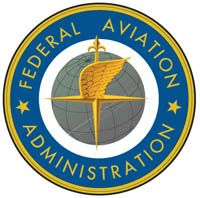 Some FAA goals have not changed:
Some FAA goals have not changed: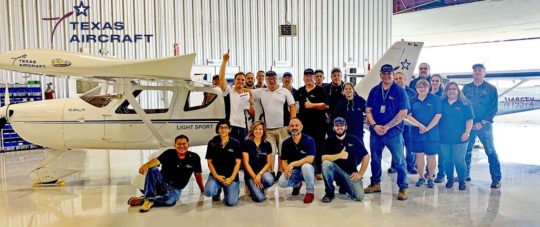
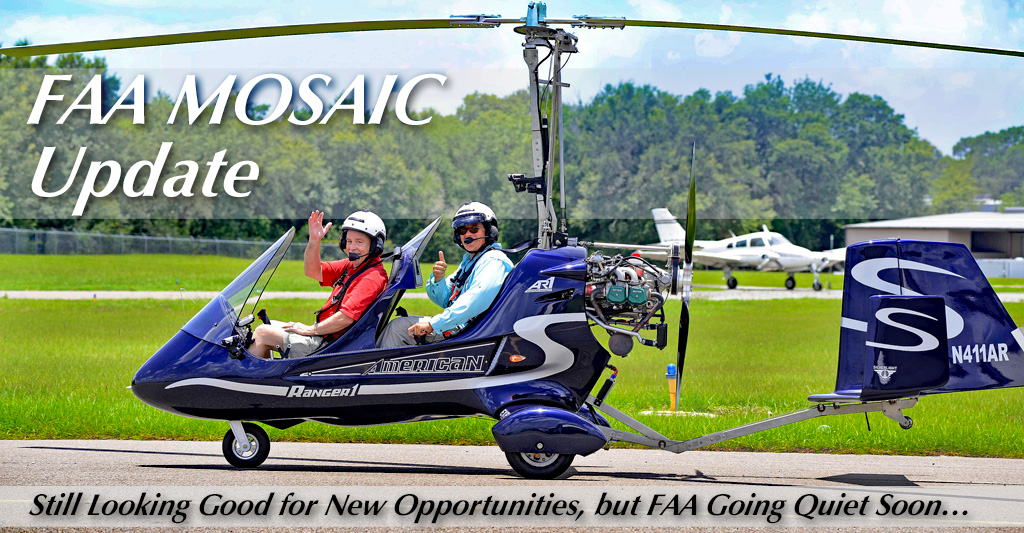
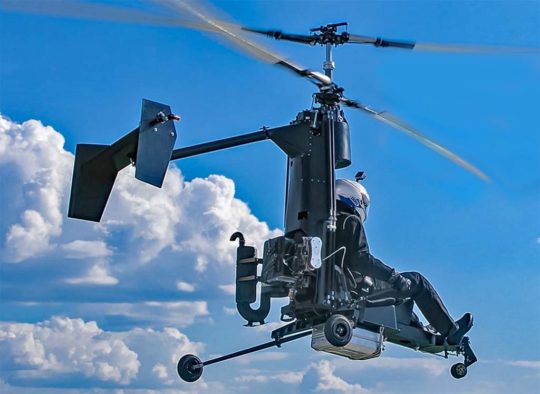 History suggests coaxial rotors originated with Mikhail Lomonosov a very long time ago, according to
History suggests coaxial rotors originated with Mikhail Lomonosov a very long time ago, according to 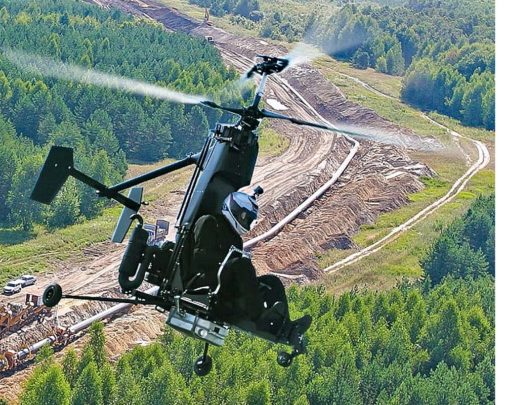
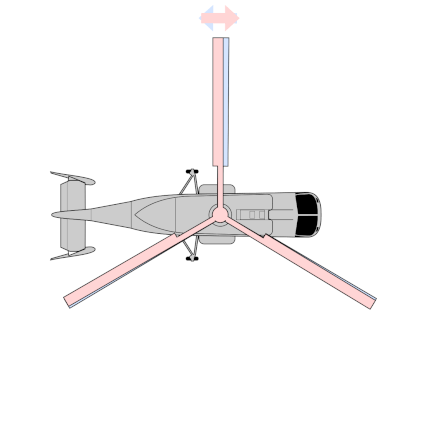
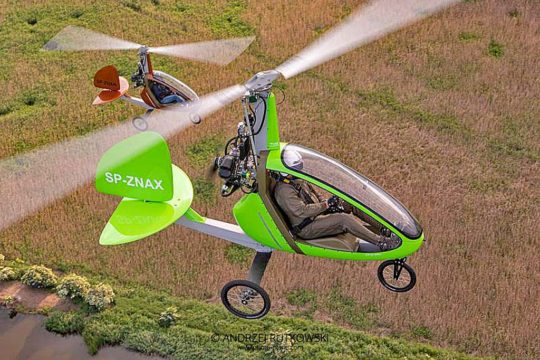 In one way Nano is similar to the original Bensen Gyrocopter. Nano is a single seater. At first, all gyros were one-seaters but since European engineers took the concept and started to advance development, I’ve seen almost exclusively two seaters.
In one way Nano is similar to the original Bensen Gyrocopter. Nano is a single seater. At first, all gyros were one-seaters but since European engineers took the concept and started to advance development, I’ve seen almost exclusively two seaters.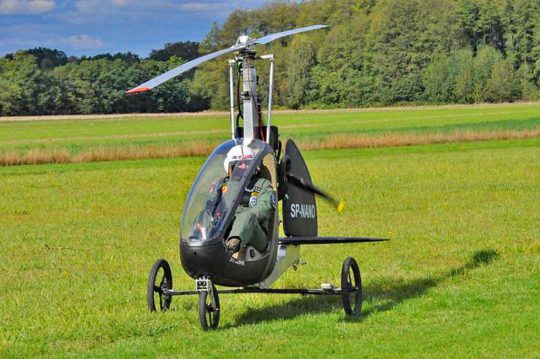 Nano is a simple gyroplane that has a partially-enclosed cabin and a fairly traditional configuration. Empty weight is listed as a modest 220 pounds.
Nano is a simple gyroplane that has a partially-enclosed cabin and a fairly traditional configuration. Empty weight is listed as a modest 220 pounds.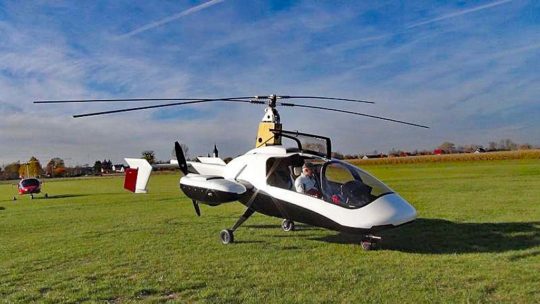
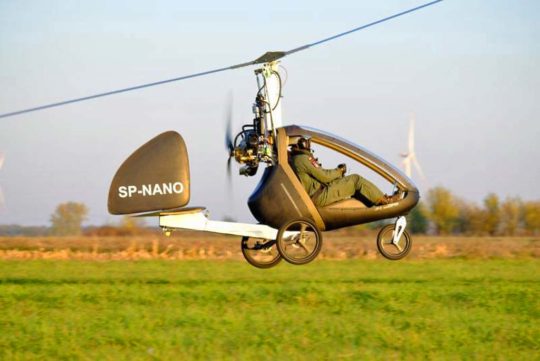 What countries are flying your aircraft? “Today they fly in Poland, Austria, Czech Republic and the next three are going to the USA, followed by two to Germany and two more to Poland.”
What countries are flying your aircraft? “Today they fly in Poland, Austria, Czech Republic and the next three are going to the USA, followed by two to Germany and two more to Poland.”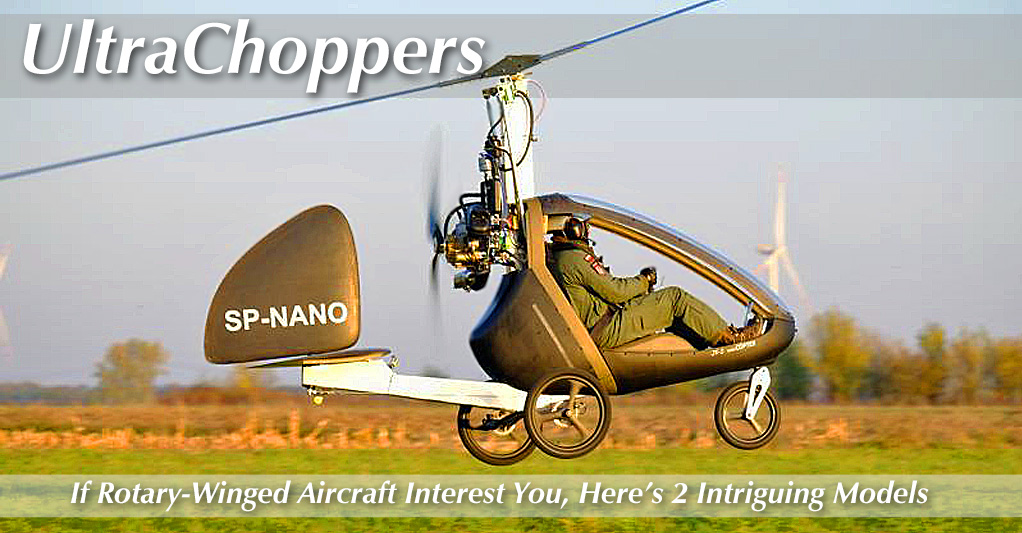
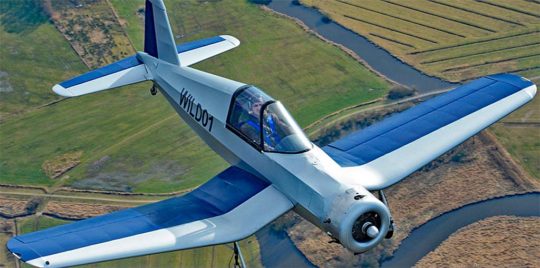
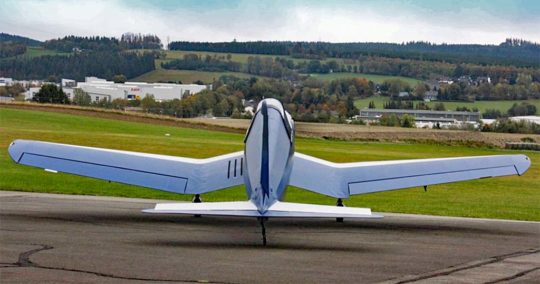 He wanted an aircraft that resembled the famous World War II F4U Corsair fighter. One glance at the nearby photos or the two videos below tells you he did very well. Here’s a bit of history about Corsair’s
He wanted an aircraft that resembled the famous World War II F4U Corsair fighter. One glance at the nearby photos or the two videos below tells you he did very well. Here’s a bit of history about Corsair’s 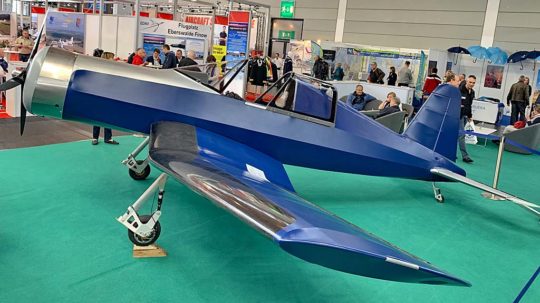 “The general layout — a low inverted gull wing — has been successfully used in several aircraft already,” explained Jörg. “The Chance-Vought Corsair surely is one of the more famous aircraft with this concept.” Jörg notes the main advantages to this configuration are a low interference drag between wing and fuselage as well as an ideal landing gear position, “which allows as well a nearly perfect angle for take off and landings.”
“The general layout — a low inverted gull wing — has been successfully used in several aircraft already,” explained Jörg. “The Chance-Vought Corsair surely is one of the more famous aircraft with this concept.” Jörg notes the main advantages to this configuration are a low interference drag between wing and fuselage as well as an ideal landing gear position, “which allows as well a nearly perfect angle for take off and landings.”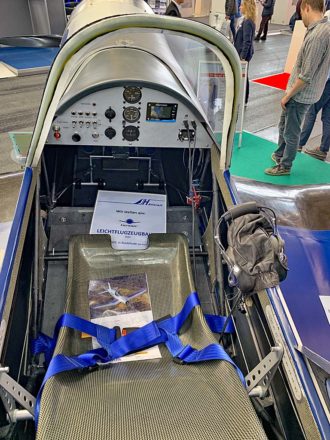 Jörg said, “We selected the Verner Scarlett 3 VW, a four-stroke, three-cylinder radial engine, [which was] purposefully designed as a light aircraft engine.” The Vernor produces 42 horsepower at 2500 rpm using a displacement of 96 cubic inches (1.6 liters).
Jörg said, “We selected the Verner Scarlett 3 VW, a four-stroke, three-cylinder radial engine, [which was] purposefully designed as a light aircraft engine.” The Vernor produces 42 horsepower at 2500 rpm using a displacement of 96 cubic inches (1.6 liters).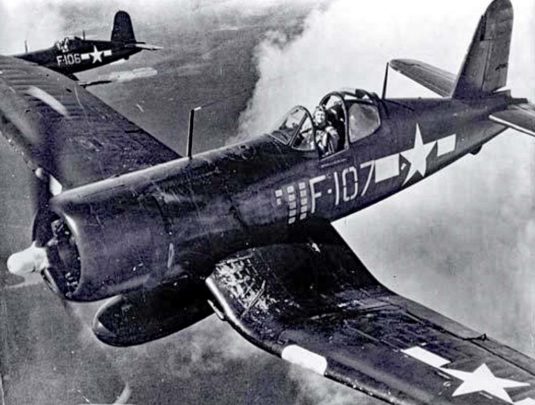 If you like the idea of a lightweight, Part 103 aircraft (no license, no N-numbers, no medical) that is certain to turn a lot of heads at any airport you visit, Corsair is definitely a distinctive and interesting ultralight.
If you like the idea of a lightweight, Part 103 aircraft (no license, no N-numbers, no medical) that is certain to turn a lot of heads at any airport you visit, Corsair is definitely a distinctive and interesting ultralight.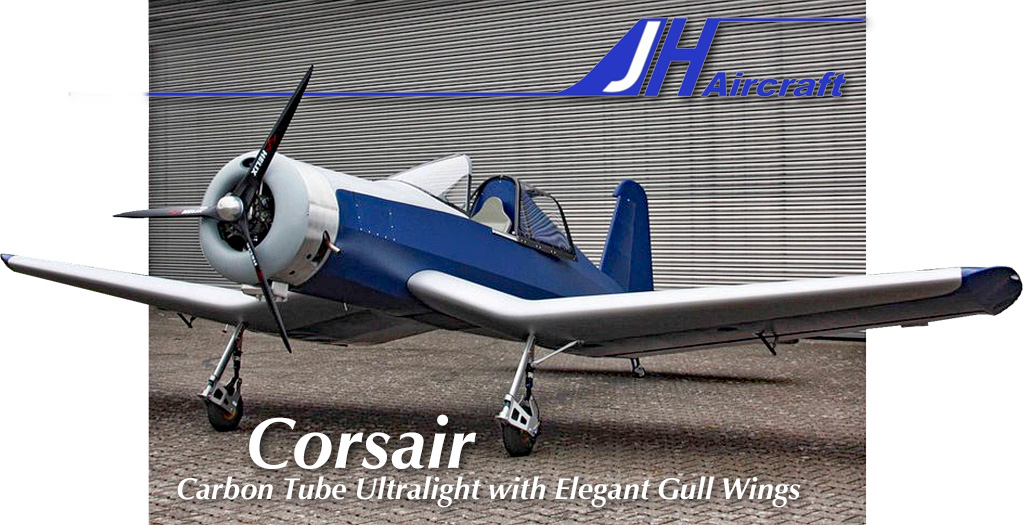
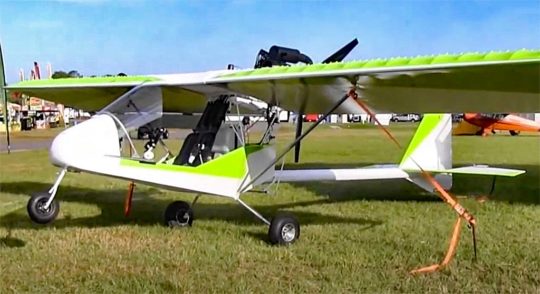 Indeed, when investigating insurance for a taildragger, you will have to prove you have some experience or get training from a suitably-experienced instructor — and you won’t find many able to help you.
Indeed, when investigating insurance for a taildragger, you will have to prove you have some experience or get training from a suitably-experienced instructor — and you won’t find many able to help you.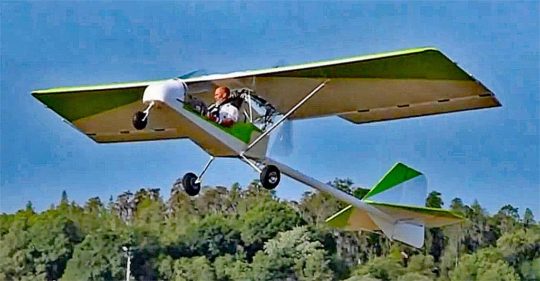 Nonsense!
Nonsense!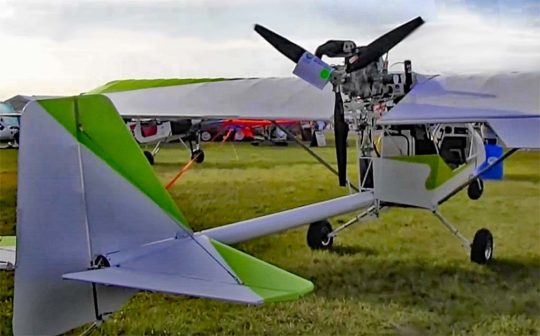 Why are single-place aircraft growing in popularity?
Why are single-place aircraft growing in popularity?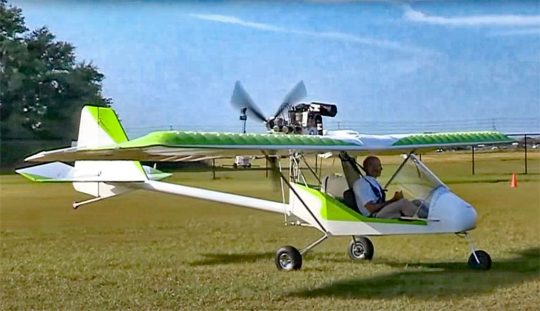 Cool as taildraggers may be, the last couple generations of pilots overwhelmingly learned to fly in tricycle gear aircraft. Most don’t care to advertise their lack of history with “conventional gear.”
Cool as taildraggers may be, the last couple generations of pilots overwhelmingly learned to fly in tricycle gear aircraft. Most don’t care to advertise their lack of history with “conventional gear.”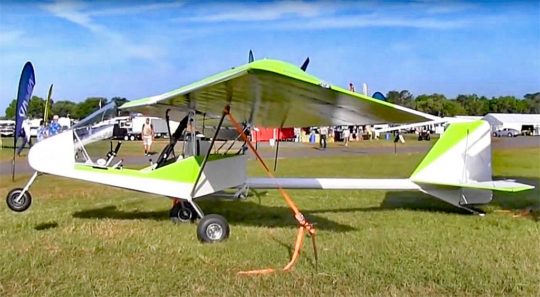 Or, if you prefer, land TriFly like any Cessna; that works well, too.
Or, if you prefer, land TriFly like any Cessna; that works well, too.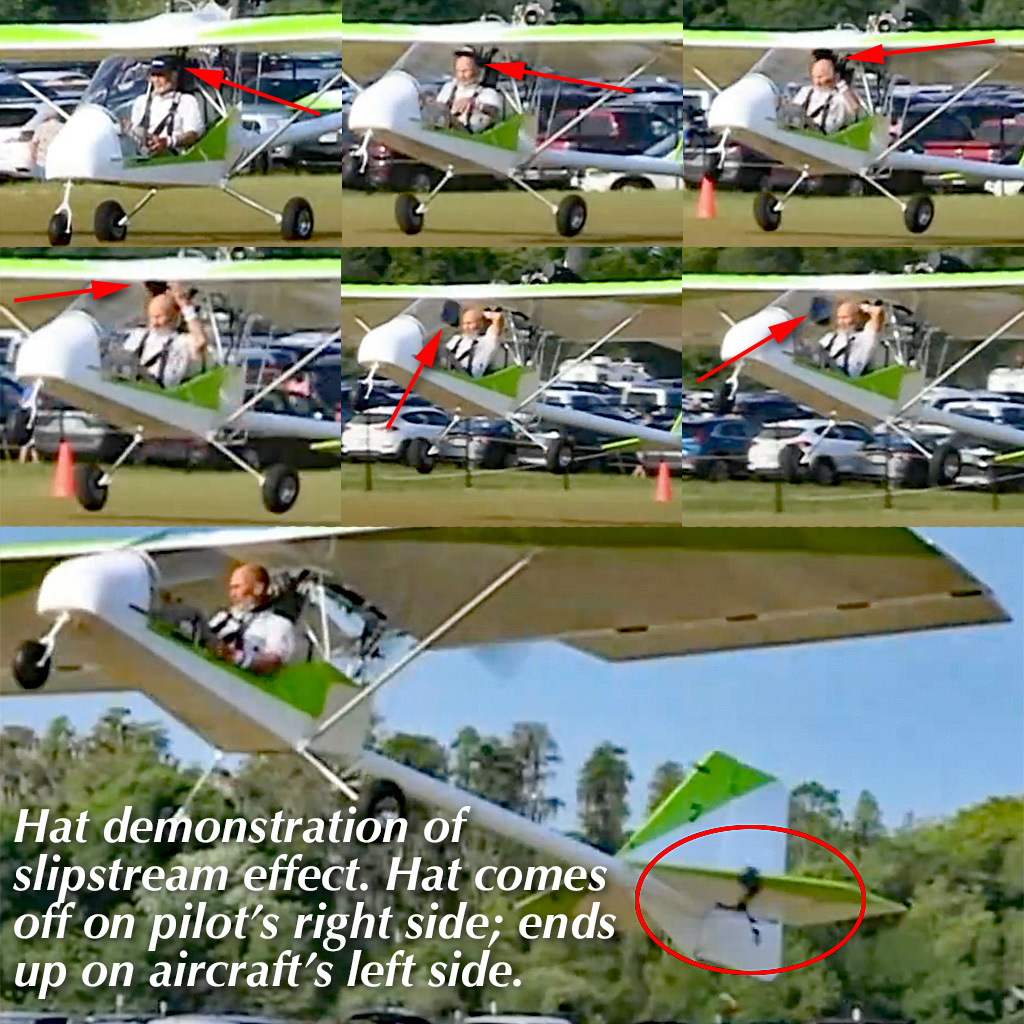
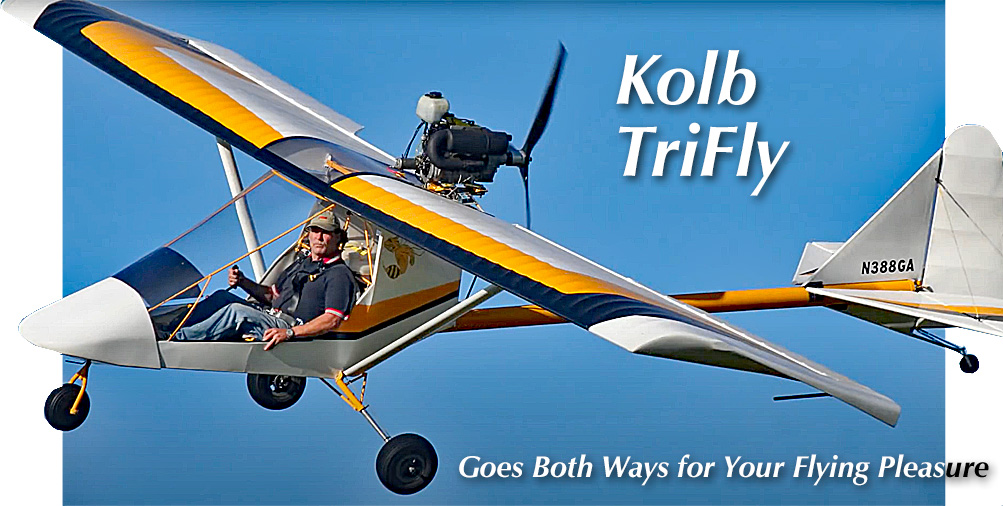
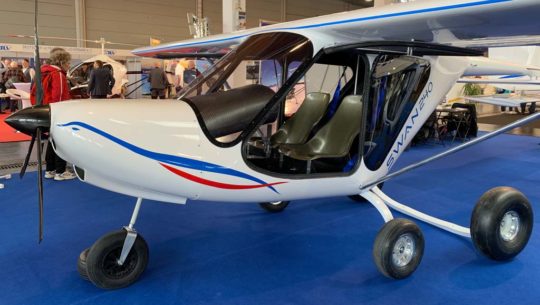 To select another aircraft type means going out on a tree limb. This is especially true with what I call “alternative aircraft” — weight shift trikes, powered parachutes, motorgliders, and gyroplanes. It would include lighter-than-air, too, if we had more than
To select another aircraft type means going out on a tree limb. This is especially true with what I call “alternative aircraft” — weight shift trikes, powered parachutes, motorgliders, and gyroplanes. It would include lighter-than-air, too, if we had more than 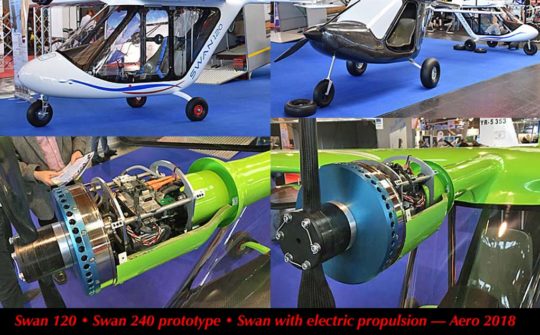 That’s great. Swan 120 is reportedly a well-flying aircraft; I have not had the chance yet.
That’s great. Swan 120 is reportedly a well-flying aircraft; I have not had the chance yet.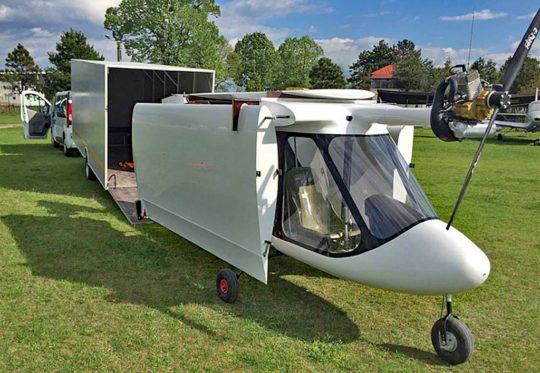 Radu owns a larger company, Avi, in Romania where he makes all sorts of industrial composite components for trains, aircraft, and backyard swimming pools. He’s an aeronautical engineer with 25 years experience in composite construction. As with similar companies, the airplane portion of the business is a smaller segment of the overall enterprise although Berceanu is very passionate about aviation.
Radu owns a larger company, Avi, in Romania where he makes all sorts of industrial composite components for trains, aircraft, and backyard swimming pools. He’s an aeronautical engineer with 25 years experience in composite construction. As with similar companies, the airplane portion of the business is a smaller segment of the overall enterprise although Berceanu is very passionate about aviation.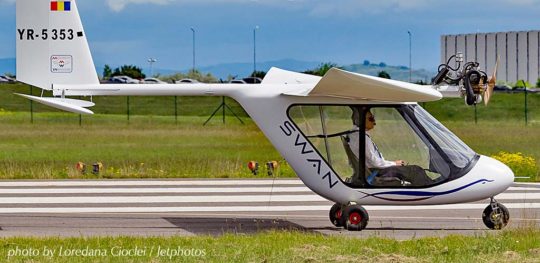
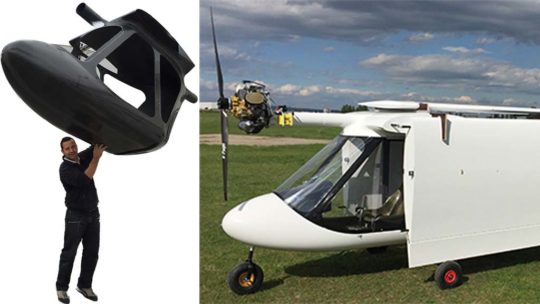 Transport & Storage
Transport & Storage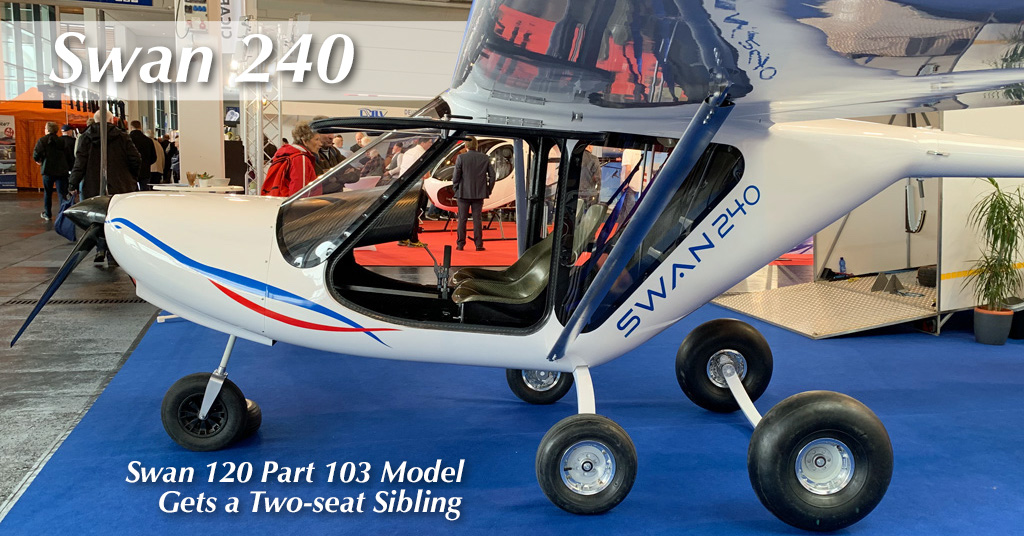
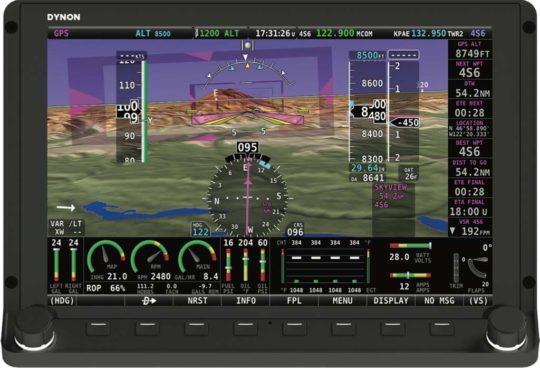
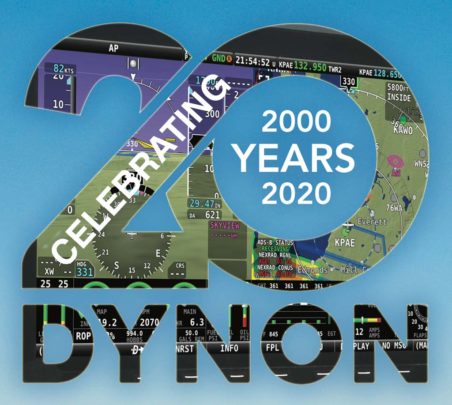 “In 2000, we were frustrated with the lack of affordable modern avionics for sport aircraft,” remembered Dynon, “and [we] decided to do something about it.”
“In 2000, we were frustrated with the lack of affordable modern avionics for sport aircraft,” remembered Dynon, “and [we] decided to do something about it.”